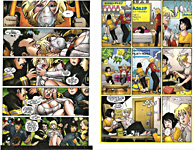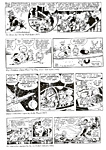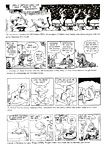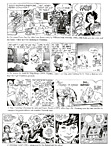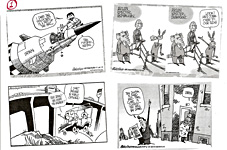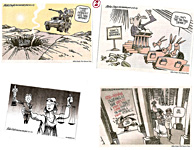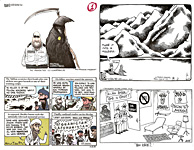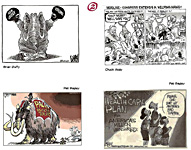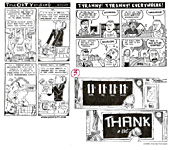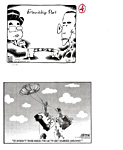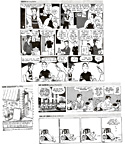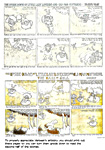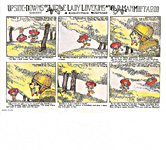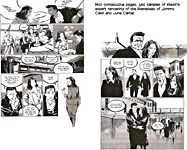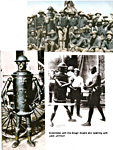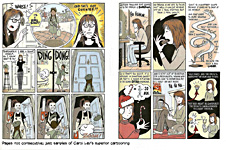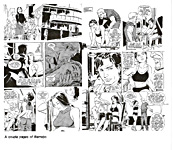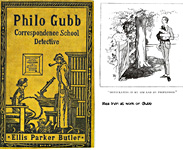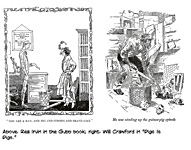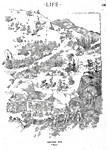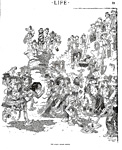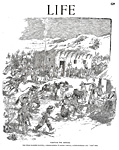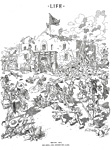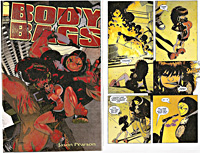 |
||||||||||||||||||||||
Opus 252 (November 30, 2009):To help out on your Christmas Wish List, we start reviewing likely candidates for it, beginning with Prince Valiant then Verbeek’s Upside-Downs, R. Crumb’s Genesis, and more. We also take a look at the venerable NEA Christmas Strip and decry the widely circulated rumor that newspapers are dying. Plus great wads of newsy bits. And don’t forget, when shopping for Christmas, that our Monster Book Sale still has many many unsold books on hand. Here’s what’s here, in order, by department:
NOUS R US More Islamic Hooliganism New York Post Sued for Monkey Business Family Guy Playboy Death Watch LANG SYNE Anyule Strip from NEA EDITOONERY Keefe’s Prize-winning Cartoons Editoons on the News of the Day (including Sarah the Palin) NEWSPAPER COMICS PAGE VIGIL Brad and Toni in Bed at Last! CHRISTMAS WISH LIST Book Marquee: Books Someone Could Gift You With Fantagraphics New Prince Valiant Verbeek’s Upside-Downs Johnny Cash Graphic Novel Crime Stories Carol Lay’s Skinny BIG BOOK REVIEW R. Crumb’s Illustrated Book of Genesis COLLECTOR’S CORNICHE Rea Irvin and Will Crawford and Pigs Is Pigs FUNNYBOOK FAN FARE Stumptown Body Bags THE FROTH ESTATE Newspapers Aren’t Dying After All (and Neither Are the Funnies) And our customary reminder: don’t forget to activate the “Bathroom Button” by clicking on the “print friendly version” so you can print off a copy of just this installment for reading later, at your leisure while enthroned. Without further adieu, then, here we go— ***** NOUS R US All the News That Gives Us Fits Alan Gardner at DailyCartoonist.com reports that Duke University’s Voltaire Press has published Muhammad: The “Banned,” a book by Gary Hull that prints all twelve of the Danish cartoons that inflamed the Muslim world three years ago. The volume includes several other images of Muhammad by such notables as William Blake, Gustave Dore, Salvador Dali and several Muslim artists—none of which works set fire to the Islamic world. At Amazon.com, alluding, doubtless, to the cowardice of Yale University Press, the Hull book is called “a defense of free speech and First Amendment rights, with a historical survey of images of Muhammad that includes 31 full-color, full-page illustrations.” Hull is the director of the Program on Values and Ethics in the Marketplace at Duke University. It’s about time someone bit the bullet for freedom of the press—an act of defiance yielding the kind of beneficial result that often accompanies the promulgation of truth and fact: the publication of Hull’s book of facts pours some cooling waters of reality over the conflagration of misbegotten Muslim ire at cartoons and, supposedly, at all other images of the Prophet. Perhaps to no avail. Prompted by the self-same Danish Dozen, Algeria and Pakistan are drumming up support among Islamic countries for an international treaty to protect religious symbols and beliefs from mockery, aiming to bring the matter to a vote in the United Nations. “If ratified in countries that enshrine freedom of expression as a fundamental right,” reports the Associated Press, “such a treaty would require them to limit free speech if it risks seriously offending religious believers.” Quite apart from the violence this would do to free speech and expression, the treaty would doubtless give every wack job in the world the right to scream that his religious beliefs are being ridiculed whenever the wack job is upset by something he reads in the newspaper. Like the wack job who was outraged recently at a Mallard Fillmore strip in which the term “hate crimes” appeared in the punchline. The wack job didn’t think hate crimes were funny and therefore shouldn’t be in a comic strip punchline. It wasn’t the guy’s religion that was being ridiculed, but it could have been. Crossing the line that, in this country, separates church and state can only lead to trouble. Patrick Kennedy, JFK’s nephew and a Rhode Island representative in Congress, has been asked by a Roman Catholic bishop to abstain from receiving Holy Communion because Kennedy is steadfast in his support of abortion rights. Where do you go with this? Scott Roeder, the guy who murdered an abortion provider in Kansas, is preparing to argue in court that his heinous act was a sort of self-defense on behalf of the unborn who would be killed by the abortionist. Surely he is motivated by a religious belief of some kind. In Pakistan, incidentally, Saeed Shah of the McClatchy Newspapers reports that a retired Pakistani army major has been arrested “for his suspected role in an alleged plot hatched in the U.S. to assassinate the creator of [one of the] controversial Danish cartoons of the Prophet Muhammad.” The arrest “will fuel growing fears about the radicalization of Pakistan’s army and particularly the links between former army officers and Islamic extremists.” ***** Bloomingdale’s in New York is celebrating 75 years of the Man of Steel by flogging all sorts of Superman stuff in the store—tees, ties, wallets, socks, pj’s, scarves, all created by cult-favorite designers. ... To celebrate its 60 years of giving out awards, the National Book Awards asked readers to choose the best fiction winner in the awards’ six-decade history. Finalists included The Stories of John Cheever, Ralph Ellison’s Invisible Man, William Faulkner’s Collected Stories, Thomas Pynchon’s Gravity’s Rainbow, The Collected Stories of Eudora Welty, and, the winner, The Complete Stories of Flannery O’Connor. ... The sentencing of Christopher Handley, who, last May (see Opus 243), pled guilty to possessing child porn, still hasn’t occurred, according to Comic Book Legal Defense Fund HQ. The guilt he admitted to could result in a combined maximum penalty of 15 years in prison, $500,000 in fines, and three years of supervised release. ... China’s economic planning agency has approved a proposal to build a Disney theme park in Shanghai, the country’s commercial and financial hub. ... Joel Silver, the producer of the new Robert Downey, Jr. “Sherlock Holmes” film, sold Warner Bros on the idea of an “intellectual action hero” by pitching with a comic book version of his concept. Said Silver: “The minute they saw the comic book, they said, ‘Oh, we get it!’ Comic books tend to be something they get pretty quickly these days.” From DailyCartoonist.com: After 35 years as the editorial cartoonist for the News & Observer, Dwane Powell is retiring. According to an announcement in the paper, Powell came to Raleigh in 1975 after editooning in Arkansas, San Antonio and Cincinnati. Said Powell: “The N&O was what I really considered a dream job for a cartoonist. It was a paper that had a strong journalistic ethical standard. It was in a capital city. And they offered me the freedom to do what I wanted to do.” Last year, Powell was told his position was being downgraded to a part-time, and he decided to quit instead, readers protested so vigorously that the paper compromised and kept Powell on. Now that he’s leaving, the paper has no plans to replace him, but the editor hopes that the cartoonist will contribute from time to time. With Powell’s retirement, Kevin Siers with the Charlotte Observer is the only staff editorial cartoonist in North Carolina. GoComics announced that Corey Randolph, who produces The Elderberries for newspaper syndication and three web strips (Barkeater Lake, Toby Robot Satan and Greene With Envy), is starting a new strip, Angry Eyebrows. Randolph claimed that doing four strips pushed him to the brink of insanity, so to preserve what is left of his brain, he invented another strip, which, he claims, will allow him to continue to create stories starring his beloved creations, but with a schedule that wouldn’t cause his skull to explode. Angry Eyebrows—“a strangely self-aware web comic”—will use the characters from all the other strips, even the cartoonist who creates them. I’m not sure how this eases Randolph’s workload, but it’s his brain that needs relief, not mine. Angry Eyebrows replaces Greene With Envy, which will now be absorbed into the AE daily strip along with new stories starring the Barkeater Lake crew and the cast of Toby Robot Satan. Barkeater Lake and Toby will continue to run on Gocomics starting with the beginning strips and occasional commentary from Randolph. The Slesingers are reportedly suing Disney again. Or still. Parts of their legal tiff were thrown out of court recently, but while a judge established Disney as Winner the Pooh’s owner, the Slesingers say they are owed 2% royalties which, they allege, Disney is underreporting at the rate of hundreds of millions of dollars. I think this is how the whole thing began before everyone got sidetracked into other legal backwaters. Incidentally, Shirley Slesinger, who started the legal action several years ago, has since died; a former Zigfield Follies girl, her second marriage (her first was to Steven Slesinger, a packager who purchased rights to Pooh) was to Snuffy Smith’s Fred Lasswell. The lawsuit filed against the San Diego Union-Tribune by its former editorial cartoonist, Steve Kelley, has been thrown out due to lack of “evidence of any unfair or unlawful business practice.” In his suit, Kelley accused his former employer of intimidating current Union-Tribune editoonist Steve Breen to prevent him from developing a comic strip with Kelley. According to the Voice of San Diego, the judge noted that Breen testified that he quit the collaboration because “he did not see the ‘magic’ in the strip, because of his workload and because he did not want to upset his employer.” Kelley’s attorney said he’ll ask the judge to reconsider; he’s also considering an appeal. Meanwhile, Kelley has teamed with another of the editorial cartooning persuasion, Florida Today’s Jeff Parker (who also alternates with Mike Peters in drawing Mother Goose and Grimm), to launch the strip. Called Dustin, it features an unemployed twenty-something still living with his parents. Maybe the concept seemed lame a couple years ago when Breen started working on it; now, it seems painfully pertinent. Two Nicholasville, Kentucky library employees were fired recently because they violated library policy by preventing a child from checking out League of Extraordinary Gentlemen: Black Dossier. A controversy resulted and was perpetrated, Icvw.com said, in the monthly meeting of the Jessamine County Public Library Board. Opinions from the public were about evenly divided on whether the book should be accessible to children or whether it should be in the library at all. The Lexington Herald-Leader reported that one parent, identified as “an evangelist,” waved copies of pages of the book at the Board and proclaimed them pornography. A woman responded: “It becomes dangerous to democracy, to our way of life, when an individual or special interest group tries to impose their values on our whole community.” Another asked whether the board was “desensitized as to what is lewd, what is disgusting.” The Board explained its policy, which seems eminently reasonable to me: parental consent is required for a child to receive a library card, after which it is assumed that the parent is monitoring the child’s reading choices. After hearing the public comments, the Board said that it might or might not take action on the library policy for under-age users. Black Dossier had already survived a challenge brought by one of the library employees who was terminated, so the book was not being considered for removal from the collection. Stephen King, saith the New York Times, will co-write a new series of comic books entitled American Vampire. Several King books have been adapted to comics by Marvel, but this, apparently, will be an original work, concocted expressly for the four-color medium. The title’s first five issues will each contain one story written by King; the other, by his “co-author,” Scott Snyder. Snyder had written King a fan letter, hoping to get him to blurb Snyder’s American Vampire; King was intrigued and offered to write some stories for the title. “Snyder’s story features a vampire named Parl seeking fame during the jazz age, while King tells the tale of ‘Skinner Sweet, the first American vampire who does not fear the sun.’” Rafael Albuquerque will illustrate. Entertainment Weekly recommends Jim Carrey’s website, jimcarrey.com, callling it “an engrossing oddity [that] does what few other celeb pages can: it keeps us interested.” I agree, but it’s not as easy to get to the website as it seems: jimcarrey.com might take you to an “unofficial fan site”; you want the “official” site. You’ll know when you get there because Carrey’s face is looming over an assortment of smaller Carrey’s in various absurd roles and costumes, which, when you click on individually, morph into elaborate and even more absurd pictures, mostly animated in the manner of Terry Gilliam on the old “Monty Python” show. ... Jeff Kinney’s fourth Diary of a Wimpy Kid was just published with an initial press run of 4 million. (And he’s the first to admit that he couldn’t make it as a cartoonist, so he did these books instead, using stick figures like Stephen Pastis, who also got famous doing the same kind of drawings. Phauw.) Dan Brown’s The Lost Symbol started off with 5 million, but when a million sold the first day it was out, the publisher quickly printed about 600,000 more. (And Brown can’t draw at all, not even stick figures.) Sarathan Livingston Palin’s autobiographical screed, Going Rogue: An American Life, had a first print-run of 1.5 million copies, a conservative quantity you might say, but it sold 300,000 the first day, so the publisher panicked and printed another million or so. (Sarah doesn’t draw either.) My books, I’m delighted to report, are doing almost as well (and I sometimes can draw). The annual report from the publisher of most of my tomes says the best-seller among them sold exactly 5,167 copies in its whole lifetime so far. That’s The Art of the Comic Book. The companion volume, The Art of the Funnies (about the history and aesthetic of newspaper comic strips), clocks in second with 4,358 copies. Accidental Ambassador Gordo, The Life and Art of Gus Arriola, a near masterpiece, ranks third with 3,155 copies. The typical press run at the University Press of Mississippi, where all of these originate, is about 2,000 copies; so I won’t complain. Particularly in light of the “collector factor.” As you can tell, my best-sellers are somewhat less numerous than most best-sellers in the book trade and are therefore all the more valuable (scarcity equals value). You can, however, still obtain your copies right here (or nearby). And speaking of your Anyule Wish List, which we’ll be doing soon, I posted a Monster “Used” Book Sale a few weeks ago, and many of the books on it are still available, much to my amazement. Most of these are books I mistakenly acquired thinking I didn’t already have a copy, so many are virtually new, or, at least, unread. And all are offered at half-cover-price or less. Don’t miss it if you can. ***** MORE MONKEY BUSINESS. Remember Travis? He’s the 200-pound chimp that attacked a Connecticut woman last February and became thereby the visual allusion in a Sean Delonas editorial cartoon in the New York Post about the stimulus legislation that many alleged was a threadbare racist slur, equating our African American prez with a monkey. The woman, Charla Nash, appeared lately on “The Oprah Winfrey Show,” and the Associated Press, announcing Nash’s appearance, reviewed the February incident, saying Travis “ripped off Nash’s hands, nose, lips and eyelids.” I decided I didn’t want to view the damage by watching her on Oprah. But the description of the damage makes Delonas’ so-called thinking all the more dubious: he made a cartoon out of an allusion to the woman’s personal tragedy, and the extent of that tragedy makes the cartoon triumphantly tasteless. Meanwhile, on November 9, Sandra Guzman filed a lawsuit against the Post,
alleging that she was fired over the cartoon incident. She had worked at the newspaper
as associate editor since July 2003, repeatedly receiving glowing performance
evaluations. The suit alleges that Guzman was subjected to a hostile work environment
in which, google.com reports, women and minority employees continually encountered
sexist and racist comments. According to the lawsuit, Guzman's fate at the newspaper
was set when she tearfully told a Post human resources executive that the newspaper
should apologize to the public and its employees for the cartoon ***** FROM OUR FAR-FLUNG CORRESPONDENTS. At DailyCartoonist.com, Alan Gardner published three reports by cartoonists who lately tripped through the sands of the Middle East to entertain U.S. troops serving in the region. Mad’s Tom Richmond was part of the National Cartoonists Society/USO group that went to Iraq, Stone Soup’s Jan Eliot and editoonist Daryl Cagle went to Algiers for the 2009 Festival International de la Bande Dessinee d’Alger and then went on to Morocco (Eliot), Egypt and Israel (Cagle). Here are excerpts from two reports: Cagle: After Algeria, my Middle East speaking tour took me to Egypt, Israel and the Palestinian territories. At my first event in Cairo I spoke to a group of Egyptian journalists who brought a newspaper up to me, proudly pointing out that in Egypt, editorial cartoons are often printed big and in color on the front page of the newspaper. The cartoon they showed me would make an American editor choke: it showed a spitting snake, in the shape of a Star of David; inside the snake/star was a peace dove, behind bars, and above the snake, in Arabic, were the words, “It’s not about the bird flu, it’s about the swine flu.” Richmond: We were bussed a short way to our quarters, where we discovered we had drawn a blackjack. We had been told our sleeping quarters in Iraq were subject to availability and could be tents, container housing, etc. Instead we got incredibly lucky and stayed at a facility called “Freedom Rests.” This is like the Club Med of Iraq, only instead of a sandy beach it had a sandy…uh… sand. Freedom Rests is a place where deployed soldiers can get away from the stress of their missions and relax with a 3 day pass as a reward for various accomplishments. It’s a giant warehouse-like building with multiple entertainment centers, games, computers, a gym, a pool, comfortable barracks and good bathrooms and showers. There is a 24-hour kitchen with full menu. Only a handful of soldiers were there while we stayed for two nights, but it can house up to 100. ***** Jan Eliot, after her guest appearance at the cartoon festival in Algiers and a speaking engagements in Morocco, went to Thailand to take part in Habitat for Humanity’s Jimmy & Rosalynn Carter Work Project. ***** SOMETHING ABOUT “FAMILY GUY.” Seth MacFarlane, creator of Fox tv’s “Family Guy,” was the victim of a Playboy Interview a couple issues ago, on the occasion of it’s being the 10th anniversary of the debut of the famously rude show, about which Playboy saith: “Innuendo is central to the show’s appeal, along with profanity, nudity, violence and musical numbers. ... Fans love ‘Family Guy’ for its unpredictable mix of the puerile and the surreal.” I suppose, but not being a viewer of the show, I can’t say. MacFarlane had various things to say, though, and some of them struck me as either amusing or profound; here is the culling: “We’ve been criticized for being too crude and lowbrow. What in the world is wrong with that? There’s something puritanical about people who object to fart jokes or shit jokes. That kind of laughter releases the healthiest endorphins.” “I feel as though I’m living on a different planet. It always seemed as though everyone was having a great fucking time on those old recordings. If you watch Sinatra, Vic Damone or Mel Torme sing, or if you watch Gene Kelly dance, it’s all about looking effortless, like it’s happening for the first time and they’re there purely for the enjoyment of the audience. Now it’s the reverse. If I watch Christina Aguilera, she’s working very hard, and it doesn’t look like she’s having fun. She’s sweating, and she looks as if she might possibly take a shit onstage.” About Rupert Murdoch, who owns Fox: “There are things I don’t like about Fox, most notably Fox News, but Murdoch is clearly a shrewd businessman first and a conservative second. [After all, he figured out, based upon sales of DVD boxed sets, that ‘Family Guy,’ which had been cancelled, was popular, so he brought it back in May 2005 after a 3-year hiatus] If a show like ‘Family Guy,’ with a very liberal slant, is making money for him, he’ll let it be. He seems to be taking global warming seriously. He seems to be much more of a critical thinker than the guys he employs on Fox News. If Sean Hannity could think as critically as Rupert, I might like him.” “There’s a site called damnyouall.net that is part of the ‘Family Guy’ fan site. It’s kind of hilarious because it’s a group of avid viewers. They watch every week, and every week they talk about how terrible the show is and then come back and watch the next week and talk about how terrible it is again. If the show is polarizing, it’s better than if it’s just pleasant. That’s something you see in animation fans, science fiction fans and comic book fans—all the nerds, basically. Nerds can get really angry. This is not meant to sound insensitive to their plight, but when you pour a disproportionate amount of your life force into one particular thing, you can lose some objectivity.” “The thing that drives me nuts about those Pixar movies, those DreamWorks CGI movies, is that they’re gorgeous to look at, impressive beyond belief, but not incredibly nutritious. A lot of the jokes are obvious and kind of tired.” Asked about his immortality (or mortality), MacFarlane said: “I lie in bed from time to time and think to myself, Gosh, at some point, I’m not going to exist. What the hell is that all about? I don’t believe in any kind of an afterlife. I would love to believe the Christians are right, that we’re going to some magical Candyland after we kick off. But I just don’t see how that’s possible. [So we die, the lights go off, our loved ones put us in a box, and our bodies begin to slowly disintegrate?] Right. It sucks. And it does seem like a cruel joke. Although there are people like Hitler, Stalin and Reagan who make you think, Well—maybe it’s for the best.” MacFarlane reports that one episode they did this year Fox won’t air: it’s an abortion story, but it’ll be released on the DVD. ***** MORE ANIMATION NEWS. Kick-Ass, the comic book send-up of superheroing by Mark Millar and John Romita Jr., will re-appear, soonish, as a movie starring Nicolas Cage, directed by Matthew Vaughn. The movie will include an animated sequence about the origin of Big Daddy and Hit Girl, which Big Daddy ostensibly is telling as a comic book that he draws. Romita is directing and drawing the sequence. Jami Philbrick at Buzz Up, asked Romita what the experience of doing animation was like for him. And Romita said: “It’s more of a great story than it is an effort because if someone tells you that you’re going to direct an animated sequence, and then do the art work for the animated sequence, people are going to think that you’re working on it for the rest of your life. What Matthew has is this great computer program that was from the Spielberg dinosaur movie, ‘Jurassic Park.’ It’s the updated version of it that takes simple drawings and 360-degree models, and you can adapt it from that. In other words, you don’t have to draw 64 frames per second. Anyway, he said to me, ‘Frame this section out as you would a comic, and we’re going to animate it.’ ... It’s about sixty or ninety seconds depending, but Matthew’s just tweaking a few of the frames, and I’ve got about sixty drawings left to go.” The movie is supposed to debut just as the seven-issue comic book series is re-issued as a graphic novel; and then the movie will also serve to launch the next Kick-Ass comic book story arc. ***** ABOUT HER CHEST. Jill Pantozzi at GEN (Girl’s Entertainment Network) talked to DC Comics' artist Amanda Conner about Power Girl: What's in store for our favorite busty hero, Pantozzi wanted to know, and why exactly is she so busty? “I love this character,'" said Conner. She was very excited about the project initially and then realized how much work it would involve. "Right now, I'm sort of doing an 8 a.m. to 2 a.m. around the clock schedule, and it's killing me, but I'm having fun," she said, "I do wish that I could work a lot faster than I do but, you know, I can't skimp on all the details. It's just not in my nature and I love doing it so I'm just drawing as fast as I can." Pantozzi brushed aside such enthusiasm to get to Power Girl’s anatomy: “Inevitably, when talking about Power Girl, two big things come up again and again—her breasts.” To which Conner reposited: "Power Girl's ‘boobs thing' has been, like, part of the ongoing joke for years now and instead of giving her these gigantic boobs and pretending nobody's noticing, I think that's a little weird because everybody notices, so we just went tongue-in-cheek about it and acknowledged it," she said. The character’s profound cleavage is vividly displayed by her costume, which has a giant hole where Superman's "S" would be. “Most people using the character play it for jokes,” Pantozzi said, “but in JSA: Classified, writer Geoff Johns finally addressed the matter in a conversation Power Girl had with Superman: ‘People always ask me why I have this hole right here. They think I'm showing off ... or just being lewd. But the first time I made this costume, I wanted to have a symbol, like you. I just ... couldn't think of anything. I thought eventually, I'd figure it out. And close the hole. But I haven't.’” I can see why filling up the hole with her nom de guerre initials wouldn’t work: “PG” is still, in some regions and climes, slang for “pregnant.” “A lot of times,” Pantozzi concludes, “the people who do feel like it's sexist haven't even read the book. There are still detractors who call the character sexist but not as many as you'd think.” Said Conner: "We don't get that too much actually. A lot of girls who read it seem to like it a lot and they don't feel like it's sexist. A lot of times, the people who do feel like it's sexist haven't even read the book. So they don't get the, wink-wink, nudge-nudge, of it, you know?" Conner admits she does get asked two questions frequently: "'But why do you have to draw her with such big boobs?' and I say, ‘Cuz it's Power Girl!’ And they're like, ‘Well, why do all superheroines have such big boobs?' and I say, ‘They don't!'" Conner prides herself on variety in her illustrations. "I wanna do all the superheroes acting differently, built differently, just because that's how real humans are, everybody's different," she said, "When I draw Catwoman, I try and draw her very streamlined because she has to break into places and steal stuff. Or Supergirl, she's what? Sixteen? I don't give her giant, Power Girl-sized boobs because she's still a teenager, you know? There are girls with big boobs out there, and I'm sure they appreciate that." I appreciate the boobs, but I dote even more on Conner’s sense of humor, which
she unveils often, page after page, frequently in small naturalistic details. Here, for
instance, is a page from No. 5 on which a few medics are bringing ***** PLAYBOY DEATH WATCH. A new round of rumors has bubbled up, this time fostered by Bloomberg News, which, on November 9, reported that Playboy is in negotiations with Iconix Brand Group for the latter to purchase the former. “Iconix CEO Neil Cole has done a phenomenal job of taking some of these lost brands and developing them into something,”said Gilbert Harrison, CEO of Financo, a New York-based adviser and investment bank. The December Playboy, compared to recent feeble issues, approaches the robust: with 176 pages, it offers 6 full-page color cartoons, plus 8 smaller ones, plus 7 Christmas cartoons on a two-page spread, and a 5-page excerpt from Robert Crumb’s Book of Genesis (for our review, keep on scrollin’). Over-all, the ratio of cartoons to pages you must turn before encountering one is 1/6 (one cartoon every six pages); full-pagers, 1/30. Still not as voluptuous as in the magazine’s heyday: December issues ran better than 300 pages for years and always included a two-page spread of comic Christmas cards or Yuletide gags. In 1967 with 320 pages, the December issue’s full-page cartoon ratio was 1/15, plus Little Annie Fanny; in 1972, the 346-page December issue’s ratio for full-page cartoons was 1/24 plus a half-dozen cartoon Christmas cards. ***** Playboy Hugh Hefner may be on the verge of losing his magazine, but he’s still got the Mansion and all those GFs. His onetime chief rival, Bob Guccione, whose Penthouse threatened Playboy’s hegemony, is living comfortably but in less flamboyant digs. Guccione lost his company in a bankruptcy sale in about 2005 and sold his Upper East Side Manhattan mansion (made by combining two adjacent town houses) and now lives with his fourth wife in a modest house in Englewood Cliffs, New Jersey. The December Vanity Fair reports that he spends his time painting these days (he started Penthouse as a way to finance an art career), working on a memoir, and hustling a lawsuit against the man who bought Penthouse who, Guccione claims, reneged on an agreement to keep the founder on as a $500,000-a-year consultant. Fascinating Footnit. Much of the news retailed in the foregoing segment is culled from articles eventually indexed at rpi.edu/~bulloj/comxbib.html, the Comics Research Bibliography, maintained by Michael Rhode and John Bullough, which covers comic books, comic strips, animation, caricature, cartoons, bandes dessinees and related topics. It also provides links to numerous other sites that delve deeply into cartooning topics. Three other sites laden with cartooning news and lore are Mark Evanier’s povonline.com, Alan Gardner’s DailyCartoonist.com, and Tom Spurgeon’s comicsreporter.com. And then there’s Mike Rhode’s ComicsDC blog, comicsdc.blogspot.com and Michael Cavna at voices.washingtonpost.com./comic-riffs . For delving into the history of our beloved medium, you can’t go wrong by visiting Allan Holtz’s strippersguide.blogspot.com, where Allan regularly posts rare findings from his forays into the vast reaches of newspaper microfilm files hither and yon. QUOTES & MOTS “Never believe anything in politics until it has been officially denied.”—Otto von Bismarck “A suicide hotline is where they talk to you until you don’t feel like killing yourself. Exactly the opposite of telemarketing.”—Woody Allen “What is the difference between Bird Flu and Swine Flu? For Bird Flu you need tweetment, and for Swine Flu you need oinkment.”—Phil’s Phunny Phacts “A professional is someone who can do his best work when he doesn’t feel like it.”—Alistair Cooke “It is forbidden to kill; therefore all murderers are punished unless they kill in large numbers and to the sound of trumpets.” —Voltaire LANG SYNE BOTH OLD AND NEW Tis the season for chestnuts by the fire. In song and custom, chestnuts by the fire are roasted. But we’ve convened this meeting not to roast anything or anyone but to warm ourselves before the freshly kindled flame of fond recollections. For these chestnuts, old and not-so-old, are the stuff of anyule memory, and all of those are the best kind. Or they should be. For as long as anyone can remember, the Newspaper Enterprise Association has served up a special three-week holiday comic strip to subscribers to the NEA package. In the December 1981 issue of Cartoonist PROfiles, Ernest L. “East” Lynn was among several NEA personages who were surveyed for comment on the Yuletide custom. Lynn was dean of comic art at NEA from 1924 to 1964, and he said the Christmas Strip had started before his time. And that would make this year’s offering at least the 85th return engagement. But Lynn was probably wrong. NEA publicity this year claims 1937 as the inaugural year, but in Allan Holtz’s Stripper’s Guide (and a few other places to which he resorted), 1936 is cited as the first year. That year, NEA circulated Clement Clark Moore’s “A Visit from St. Nicholas” as interpreted by cartoonist George (The Comic Zoo) Scarbo. Lynn’s recollection was, then, somewhat off. Others have told me since that what he was probably remembering as having started “before his time” was the “X-number of Shopping Days Until Christmas” feature, a cartooned count-down designed for newspapers to run in otherwise negligible corners of their front pages during December. The Christmas Strip is usually produced by NEA cartoonists who ladle out this cup of seasonal cheer in their so-called spare time while also doing their own features. Walter Scott, whose regular gig was The Little People, probably brewed more Christmas Strips than anyone else: his byline was on the feature through the 1950s and well into the next decade. And he also produced the first original material for the NEA Christmas Strip, Sailor Sally and Meany Mo, in 1937. Mad cartoonist Wally Wood is one of the rare outsiders to produce the strip: in 1967, his offering was entitled Bucky’s Christmas Caper and was, typically, mulled in space ships seasoned with the sf gadgetry the cartoonist doted on. In recent years, NEA cartoonists recruited for the assignment have used the characters from their regular strips to moonlight in the Christmas outing, among them: Bill Schorr (The Grizzwells), Jimmy Johnson (Arlo and Janis), and Greg Evans (Luann), to name a few. This year, it’s Dan Thompson’s turn, and he has drafted his mock-adventure strip hero, Rip Haywire—“soldier of fortune, contemporary action hero, and big lug”—to appear in a Christmas Epic entitled “Rip Haywire: Away in the Danger.” Debuting earlier this year, Rip Haywire is “a throwback to a bygone era of adventure comics, but with a very modern spin that gives it a look and attitude unlike anything else in papers today,” according to NEA publicity. “It’s a fast-paced, globe-trotting combo platter of danger, dysfunctional romance, and comedy (often at the expense of our noble hero).” (For more, see comics.com/rip_haywire/.) The 17-strip Christmas series begins with Rip telling his cowardly pet pooch TNT that he wants to buy his ex-girlfriend/adventure sidekick/erstwhile villainess foe, Cobra, a gold bracelet. The NEA press release takes if from there: “While out for a Christmas Eve stroll, Rip and TNT run into an old, white-bearded man who asks Rip to deliver a parcel for him. Inside a nearby house, Rip and TNT find a bomb, a desperate man, and the beginning of a riveting holiday caper. Our heroes rescue the man’s family from a sinister organization, but with all the commotion, Rip is unable to get Cobra’s gift…or is he?” The series begins December 7 and runs Monday through Saturday, ending on Christmas Day. The anyule strip is provided to NEA’s 600 clients and is also available for individual sales.
And Now, for Some Christmases Past. Here we revisit a few moments culled from NEA’s files by way of decking the halls at your house with festive images of Christmases past. Some of these may be old chestnuts indeed; but we are all the fonder of them for their vintage.
EDITOONERY Afflicting the Comfortable and Comforting the Afflicted The Denver Post’s Mike Keefe has been awarded the 2009 Berryman Editorial Cartooning Award “for a wide-ranging series of drawings that poked fun at politicians, journalists and public perceptions.” The usual array of social and political topics, in other words—sort of like saying Keefe won for drawing editorial cartoons. Judges in these competitions cannot, seemingly, explain why one cartoonist’s work is better than another’s in a given year. You’d think they’d be expert enough to do that; but they usually aren’t. Admittedly, it’s not easy to do. The Berryman judges did better in describing the work of two cartoonists they awarded Honorary Mentions to— Matt Wuerker of Politico and Ann Telnaes of washingtonpost.com—who were recognized for the "innovative use of animation in their work, which is expected to be the wave of the future." Wuerker’s work can be seen at www.politico.com/wuerker/animation.html. When I congratulated Telnaes, she told me she was especially pleased at the recognition because she believes it’s the first time an all-animation entry has been honored: usually, animated entries are considered in such competitions only as part of a cartoonist’s work, the rest of which is print. Although Telnaes did editorial cartoons in print for years, her work is now entirely in animation. A Pulitzer Prize and previous winner of the Berryman, she hopes the Berryman nod at animation will help open up job opportunities in the profession. Despite carping about judges’ inability to describe cartoonists’ work, I should, in fairness, mention that the National Press Foundation’s press release announcing the awards included descriptions of several cartoons by all the honorees. And it concludes with this: “In another gesture towards the historically important venue of cartooning, the judges awarded a Certificate of Merit to cartoonist Bill Day, for a series of graphically powerful images highlighting child abuse. One showing a small child facing an enormous fist hardly needs a caption at all.” Day is the former editorial cartoonist of the Memphis Commercial-Appeal, now syndicated by United Feature Syndicate. His work can be seen at www.unitedfeatures.com (because he’s no longer at the Commercial-Appeal: the paper laid him off months ago in an economy ploy now typical of so many newspapers). Distinguishing one editoonist’s work from another’s is, as I admitted earlier, not easy. It may even be almost impossible. But we can at least appreciate good work in a sort of generic way when we see it. Here are some of Keefe’s good ones from the last several months.
On the first page (the one with the red encircled “1"), all of the cartoons deploy imagery rather than mere verbiage to make their points—the guided missile, the fence, the coat hanger, and off-road travel (which was described in the NPF press release). The image in the abortion cartoon derives its power from the sanctimonious religious context created by the first figure in the cartoon. In every instance on this page, the imagery contradicts the verbal content. On page 2, Keefe employs imagery in a somewhat different manner. None of the visuals here contradict their verbal content. At the upper left, the cartoon’s over-all imagery invokes the roadside bombs of the wars in Iraq and Afghanistan. To the right, the visual setting is a church and the verbal information creates the irony that conveys the message. At the lower left is one of Keefe’s most telling images: here, child molester Roman Polanski is clearly being “tried” by a different scale of justice, one in which an Oscar weighs heavily. The fourth cartoon is less complex visually, but Keefe’s exaggerative portrait of The Right conveys comically the panicky irrational extremity of The Right kind of so-called “thinking” these days. Another of Keefe’s recent cartoons is too delicious to avoid mentioning. He depicts a school teacher standing outside a school building on a wintery day, holding a paper labeled “State Budget K-12" and saying to pupils huddled before her, “I’m afraid we’re going to have to let some of you go.” It illustrates how laughable (and therefore inappropriate) governmental solutions to budget shortfalls can be if they apply the alleged “logic” of business to public services. The Berryman Award, which includes a $2,500 prize and a crystal trophy, will be
presented to Keefe at the 27th annual National Press Foundation Awards Dinner,
Tuesday night, February 16th, 2010, at the Washington Hilton Hotel. *****
THE BIG NEWS OF THE LAST FEW WEEKS goes from the terrifying to the ridiculous, as usual. The terrifying part took place at Fort Hood. Reports throughout the misnomered news media immediately identified the perpetrator as a Muslim thereby betraying a bias too frequently indulged in these paranoid times. What religion is the guy who killed the abortion provider in Kansas? The shooter at Virginia Tech? Or what about the Florida man who, on the same day as the Fort Hood tragedy was transpiring, lost his cool completely and shot up his former workplace? But few, if any, editoonists took this tack; most deployed heavy sarcasm to indict the military for failing to contain or detain mass murderer Nidal Hasan. In our first exhibit of cartoons, we have Michael Ramirez at the upper left blaming political correctness with a menacing metaphor, but it doesn’t seem to work, quite: if Political Correctness, the “unindicted co-conspirator,” is also Death, as the image suggests, how, exactly, does Political Correctness equal Death? Moreover, no matter how convenient an umbrella “Political Correctness” is for a multitude of sins, it isn’t an entirely accurate explanation for what happened with Hasan. Army authorities were reluctant to conclude that Hasan was dangerous based solely on circumstantial evidence, however high it got piled up, but I’d say that was another American trait being exercised, the one that claims one is innocent until proven guilty. Misplaced sense of justice in this instance, but probably the operative attitude. Next, moving in a counter-clockwise direction, we find Ted Rall (lower left) turning the issue on its head, as he often does, and delivering a snide comment on our propensity to find Islamic extremism lurking in Hasan’s rampage. The message—patriotism isn’t necessarily the answer—is not immediately apparent: if Sheikh Osama is acting in the third panel like Baracko Bama did, then who is the equivalent of Mullah Omar? But a limping conclusion still leaves the rest of the strip a telling indictment. In the next cartoon, Tony Auth takes sarcasm to its obvious extremity; telling imagery and, by itself, not necessarily an attack on Islam. Pundits clogged the airways with endless discussions of whether Hasan was a terrorist or not, everyone offering a different definition of “terrorist.” The only objective I can detect in defining Hasan as a terrorist is to determine what kind of court he should be tried in—civilian or military. And even judicious judgement, thanks to Attorney General Eric Holder’s decision to try five Guantanamo detainees in civilian court in New York, doesn’t seem to lead to an unequivocal outcome. Civilian courts, as the National Review Online pointed out, are for trying people accused of crimes, but terrorism isn’t a crime: it’s an act of war, and those accused of terrorism should therefore be tried in miliary courts. In the case of the Gitmo five, Glenn Greenwald at Salon.com argues that none of them are likely to ever walk free again, even if they were to be acquitted. “The honest approach,” he concludes, “would be to announce that dangerous defendants such as these will be held indefinitely as prisoners of war, under the rules established by international law.” Hasan, however, doesn’t seem to me to be a terrorist. I agree with James Fox at USA Today, who allows that Hasan may have seen his grievances through an Islamic prism, but he closely fits the profile of a typical workplace killer. Like most of the lonely, middle-aged men who show up at work one day and open fire, Hasan had recently suffered “profound episodes of failure” ... [and he] appeared to be “seeking vengeance for personal mistreatment,” even singling out certain co-workers to be shot. Is personal revenge truly terrorism? I don’t think so. Hasan is just a nutcase with a gun. He committed murder, not terror. Moreover, as Robert Kaplan said in TheAtlanticOnline.com, “By insisting that Hasan’s rampage was an act of jihad (holy war), we turn the mass shooting into a military victory for al-Qaida [and] feed into the narrative that the U.S. is at war with all Muslims,” discouraging those who live in America who might enlist in the military at a time when “our military is desperately short of soldiers who understand both Islamic culture and languages”—the kind of recruit we sorely need in the struggle at hand. Our last cartoon on the first exhibit is Tom Toles’ vivid image for a new approach to Afghanistan, one of the other preoccupations of the news media in recent weeks. By the way (although not at all incidentally), the best definition of victory in Iraq and Afghanistan is what I heard a week or so ago on “60 Minutes” from the lips of an American soldier who said: “Going home alive—that’s victory in Afghanistan.” Our next exhibit (2) of recent editoons of notable potency begins, upper left, with Brian Duffy’s ingenious image of the Grand Old Pachyderm’s much acclaimed “victory” in two state elections where GOP candidates won governorships, a celebration that conveniently overlooked the Republican loss in a historically conservative district in New York. Moving clockwise, we encounter another clever visual contrivance by Chuck Asay whose cartoon about unemployment reveals the source of the helping hand (in the background, the taxpayer’s hand is being lopped off) while also indicting the press for inadvertent deception in reporting on the issue. Pat Bagley gives us the next two lessons in civics. His comment on the GOP health care plan is fairly accurate, as far as I have been able to determine; and while the words alone convey the message, the picture of the supplicating family adds poignancy and therefore power to the comment. The much-heralded debate that is either going on in the Senate or has, by the time this gets posted, terminated is not, probably, a “debate.” A debate is where two people with opposing views argue their positions in the hope of persuading someone to change his or her mind. In the Senate confronting the health care reform legislation, no one is expecting to change anyone else’s mind. The “debate,” there, consists mostly of a succession of senators taking the microphone to bloviate at length about their convictions before a body that is shamefully undemocratic in both its rules and its representation. As Garrison Keillor recently reiterated, 41 of the 100 senators (that is, by simple math, 41 percent of the Senate) are from rural states that together represent only 10 percent of the country’s population. He continues: “Anytime 10 percent of the people can stop 90 percent, it’s like driving a bus with a brake pedal for each passenger. That’s why Congress has a public approval rating of 25 percent.” But, let’s return to Bagley, who’s much easier to understand than the U.S. Senate. Bagley’s last effort, lower left, focuses on the other Big Story of the month—Sarah Livingston Palin’s emergence from seclusion to promote her book (and, we suppose, her candidacy). Bagley’s choice of images is fascinating and full of metaphorical meaning. Sarah is presented as a circus performer, attired in fetchingly female garb (an echo of her appearance on Newsweek’s cover; see below)—an image that ridicules her for being both a performer at a circus and a woman selling herself through sex appeal. The Grand Old Pachyderm is not a modern elephant but a mammoth, a remnant of an ancient past, long dead. And then we have the moderate Republicans, trailing behind, sweeping up elephant poop—which is all they can hope to gain from Sarathan Livingston Palin. A morbid fascination compelled me to watch every interview Sarah the Palin gave in the week that launched her alleged book—Oprah, Hannity (yes, even he), O’Reilly, Baba Wawa—all of them. But am I going to read the book? No. I’m guided to this decision by a Denver Post columnist, Mike Littwin, who said, without equivocation: “If you’re thinking of buying your own copy [of the book], you should know that if you’ve seen Palin on ‘Oprah’ or heard her on ‘Rush,’ you’ve already got the basics.” What we learn from her interviews (and her book), saith Jon Cohen at TheWashingtonPost.com, is “that she is truly a vindictive, spiteful person.” She thinks Katie Couric abused the privilege of interviewing her. She feels mistreated by Team McCain. She loves those “everyday, hard-working Americans.” Her chief complaints about her run for the Veep are that Team McCain forced her to do things she didn’t want to do and prevented her from doing things she wanted to do. What a resume for President of the U.S.—a person who lets subordinates push her around. Oh, and that photograph of her in shorts—sorry: “running togs”—on the cover of Newsweek? That, she assures us, wasn’t shot for the purpose of being on the cover of Newsweek; no, it was “an old picture” taken for a Runner’s World article about her, a picture subsequently dug up and salaciously used, by Newsweek, without her permission. Or knowledge, apparently. For a Newsweek cover, she said, she would have preferred a picture of herself in a business suit. Oh, yeah. But showing a little naked thigh couldn’t hurt, eh? The Grand Old (Boy) Party is already the Joke Party, and Sarah the Palin is its parody comic book heroine in spandex. The cover photo was unquestionably a cheesy choice, and the accompanying headline didn’t help: “How Do You Solve a Problem Like Sarah?” screamed the cover, adding: “She’s Bad News for the GOP—and for Everybody Else, Too.” And Newsweek caught a lot of flack for it, too. Even those who said they were not fans of Sarathan Livingston Palin wrote it to protest the rampant sexism. Newsweek published a bunch of the letters the next week but didn’t take the episode seriously: in effect, the magazine retaliated by printing a photograph of Barack Obama in his swimming shorts, dripping water as he emerged, like Botticelli’s Venus, from the surf during a visit to Hawaii in January 2007. It was accompanied by a caption quoting Sarah about her cover appearance the preceding week: “It’s sexist and a wee bit degrading.” But Obama is showing more skin. Many, alas, find Sarah the Palin heartening rather than hilarious: “She’s a person of faith ... [and] she has gone through a lot of the trials and tribulations we have. I’d vote for her in a heartbeat,” said Lana Smith, bus dispatcher, among the mob that turned out for the opening of the book tour in Grand Rapids, Michigan. Housewives of the world, unite! What should we expect? The human brain is shrinking. At the University of Wisconsin, an anthropologist recently determined, by examining 5,000-year-old skulls and some of our own, that human brains have shrunk by roughly 150 cubic centimeters, or a full 10 percent. This explains a lot of our recent history—Britney Spears having nearly 4 million followers on Twitter, for instance, as noted by Eric Effron in The Week. It probably explains why we feel comfortable when limited in written discourse to 140 characters. And it may explain Sarathan Livingston Palin, about whom, most Republicans, said Richard Cohen in the Washington Post, “have a quite irrational belief that she would not make a bad president” because she will “act out their resentments” against the media, intellectuals, and blue state sophisticates. Let’s hope the future will not be explained by more shrinkage of the brain: I don’t think we could survive that. For the time being, however, “irrational” is the operative description of the alleged thought-processes of many Americans, and Derf (aka John Backderf) and Matt Bors on our next visual aid (3) exploit that circumstance with strips that, in the fashion of the sequential genre, pile up an indictment one panel at a time until the evidence is overwhelming—and, usually, hilarious. On the same page, Joe Heller celebrates Veteran’s Day with a canny deployment of the holiday’s iconic numerology: World War I ended, it is often said, on the eleventh minute of the eleventh hour of the eleventh day of the eleventh month. Heller gives the numbers an even larger meaning with an inventive gloss. Finally, two more on the next page (4). Toles’ use of the famous “Chinese handcuff” to illustrate the relationship between the U.S. and China is a telling visual metaphor. Many of the gasbag population have bemoaned the debt we owe the Chinese, imagining that if they ever try to collect, they’d effectively conquer the U.S. But why would they do that? As long as we owe them gazillions, we’ve made them dependent in some measure on our interest payments. Why would they kill the goose that’s laying the golden egg? Not likely. Toles’ image adroitly captures the mutual snare of the U.S.-China financial arrangement. Below Toles is R.J. Matson’s vivid indictment of the sucker the Balloon Boy made of the so-called “news” media. MORE MOTS & QUOTES “Imagination was given to man to compensate him for what he isn’t, and a sense of humor to console him for what he is.”—Sir Francis Bacon, Elizabethan wit “The true calling of an artist is to paint women and the greatest challenge is the naked female form. That’s what separates the true artists from the wallpaper-hangers.”—Garrison Keillor Headlines from Bad News Reporter: Regrouped Birthers Now Claim O’Bama Was Born in Ireland Report: Michael Jackson’s Nose Is Actually Paul Anka’s; Autopsy Shows Pop Star Also Had Perry Como’s Knees NEWSPAPER COMICS PAGE VIGIL The Bump and Grind of Daily Stripping
Other interpretations of this sequence are possible, of course—that, after all, is the whole purpose of Evans’ maneuvers, to permit readers to see something entirely harmless in the banter (although how “the most fun you can have without laughing” [Woody Allen] can be construed as harmful is debatable). But Evans clearly intends an interpretation like mine, too. We’ve known for months—ever since Brad and Toni seemed increasingly serious about each other—that, eventually, Evans would have to confront the inevitability of their balling in romantic bliss. Their congress hasn’t the poetry of Edda and Amos’ inauguration a year ago into the pleasures of the flesh in Brooke McEldowney’s 9 Chickweed Lane—their entwining hands is one of cartooning’s triumphant achievements—but Brad and Toni’s consummation devoutly to be wished is in perfect tune with their slightly flip personalities, which Evans has so carefully constructed over long months. Delightful, purely delightful. Next down the page we have another of those cameo appearances in one strip of a character from another—Andy Capp in Dan Thompson’s Rip Haywire. But Thompson has lost me with “hot fries”; what is that? Must be some Limey thing like “crisps” for potato chips. In Dog Eat Doug (another meaning that evades me), Brian Anderson gives us some hilarious visual comedy in the dog’s attempt to scale the metal mountain of a child’s backyard slide—the visualization here is perfect—topped by the erudite punchline. And to the left, Wiley Miller has launched a caption-writing contest in his Non Sequitur. I suppose the enduring success of the same sort of contest on the last page of every issue of The New Yorker has encouraged every cartoonist to think of such a contest as a way of (1) reassuring himself that he has readers and/or (2) getting someone else to do his work for him every once in a while. Neither of which is a sin. At non-sequitur.com, you’ll discover that the deadline for submitting sandwich board sayings is Friday, December 4 (which may, given the vicissitudes of the International Dateline intervening between me and Webby Lambros in Japan, have already transpired by the time you read this). And you’ll also learn the rules of the contest and see that, if you win, you will receive the original of the art for the cartoon (with your winning gag written onto the sandwich board), an autographed copy of a book of Non Sequitur cartoons, and an actual sandwich board with your witticism on it. Also autographed by Wiley. That’s a lot more than you’d get if you won The New Yorker contest. With that, we come to the end of the regular appearance of Newspaper Comics Page Vigil in these parts. I’m moving the feature to the new Comics Journal website, TCJ.com, where the bump and grind of daily stripping will appear at the astonishing rate of three installments every week. If I can keep it up. It will carry a new title, Hare Tonic, but you won’t see that on the gateway page: look instead for just ol’ R.C. Harvey. Vigil might return to this digital arena occasionally, but not often. For often, tune in to TCJ.com. CIVILIZATION’S LAST OUTPOST One of a kind beats everything. —Dennis Miller adv. Colorado breweries (of which there are more than 100, saith the Denver Post) pump out more beer—23,370,848 barrels in 2006—than any other state. Now I know why I moved here. (Maybe not: my favorite beer isn’t made in this state or even in this country. Samiclaus is made in Austria; and it isn’t a beer. Calls itself “malt liquor.”) Michael Jackson’s famed white glove sold at auction for $350,000; before the auction, it was estimated that the rhinestone-studded mitt would sell for $40-60,000. Jackson’s moonwalking fedora went for $22,000. Disgusting that while 10 percent of Americans are unemployed and many millions more hurting for money, someone has enough boodle to spend foolishly for such things. There are 237 millionaires in the U.S. Senate and House of Representatives, saith Politico.com; that’s 44 percent of all members of Congress. Only one percent of the public at large are millionaires. BOOK MARQUEE XMAS LIST: BOOKS FOR A MERRY YULE :: PART ONE Here Are Some I Thought Highly Enough Of To Put in My Library (Even, Sometimes, Without Having Actually Read Them All the Way Through. Yet.) The new Fantagraphics reprinting of Hal Foster’s Prince Valiant got a short but illustrated write-up in the October Vanity Fair: Cullen Murphy, who often writes for the magazine and who wrote Prince Val for 25 years while his father, John Cullen Murphy, drew it, applauds the improved reproduction in the new volumes. Said he: “A witch named Horrit once prophesied that Val would never know contentment, but fans of the strip will find it here.” Fantagraphics has done Foster before. Between 1984 and 2004, it published over 40 volumes reprinting all Foster’s famed Sunday pages. So why do it again? Because, Kim Thompson explains in an afterword in the first of the new volumes, since the first run, advances in digital color technology permit more faithful reproduction and—most importantly—they have access to “a nearly full set of pristine color engraver’s proof sheets of almost the entire Prince Valiant run, carefully preserved by Foster and donated to Syracuse University,” which provided scans for Fantagraphics’ use. Previous editions of Prince Valiant—the Nostalgia Press effort in the 1960s and Fantagraphics’—recolored the pages, but the color didn’t duplicate the appearance of the original publication of the strip, and the linework was often blotchy. I have the earlier Fantagraphics books, and in comparing them to the current enterprise, it’s clear that the earlier reproduction was inferior. But the present effort is wonderfully faithful to the originals: not only is the color itself much much better, but the linear detail is stunning. The current volumes reprint twice as many pages (124) per book as the previous undertaking, and the pages at 10x14 inches are slightly larger than the predecessor’s. But it’s the fabulously high quality of the reproduction that makes these volumes a bargain at $29.99 each; Volume 2 is due in the spring. **** Pete Maresca is a man possessed. I realized that within minutes of first meeting him during one of the several cocktail parties that regularly festoon the festivities at the annual Reubens Weekend convention of the National Cartoonists Society, this one in Phoenix several years ago. Pete was carrying a huge bundle under his arm and said to me, “Here—I want to show you something.” We walked over to a table nearby, and he unwrapped his bundle and put its contents on the table and opened it up: it was a mock-up of a book he said he was going to publish. A huge book. A book that would reprint a substantial selection of Winsor McCay’s watershed comic strip, Little Nemo in Slumberland, at the size the page had originally appeared in 1905. I marveled, as I usually do when beholding Nemo, at the masterful intricacy of McCay’s decorative artwork. And then came the revelation: at the size of their original publication, the pages lost the single oddity that blemished them. I had often wondered at McCay’s seeming obtuseness about speech balloons: they always looked like afterthoughts, pasted onto the artwork at the last minute, too many words squeezed into them—so many that sometimes they turned the corner and ran up the side of a balloon. Odd, I thought, that McCay, a genius of design and rendering, evidently could not see the flaw that everyone else could see. But now I understood: at the dimension of their initial appearance, the speech balloons were not too small, not crowded with excess verbiage. They were entirely okay. McCay’s Nemo at this size was even more impressive than it usually is, and it is invariably impressive. What a glorious book a book the size of this mock-up would be. As much as I admired Pete’s intention, I realized at once that he was a hopeless dreamer. As he talked about the book, it was clear that he was possessed by his dream to reproduce McCay’s masterpiece at its original published size, the size McCay drew it for. But I also knew that it would never happen: friendly as the market had become for comics-related tomes, even those reprinting classic newspaper comics, it would not support such an ambitious project as Pete proposed. A book reprinting a classic Sunday strip at its original size? Unlikely, I thought. But I smiled encouragingly. And, later, when Pete asked me to write something for the book, I did. But I knew it would never get off the ground. And even if it did—even if Pete managed to get it published—it would never sell. I was spectacularly wrong. And Pete was gloriously right. His Little Nemo in Slumberland: So Many Splendid Sundays sold out in an astonishingly short time, and Pete went back to his printer for more. And more yet, resulting in a second Nemo book, assuring the survival of Pete’s publishing company, Sunday Press Books. And then came others—all reproducing as exactly as current technology allows the Sunday comics at their intended, gigantic size. Sundays with Walt and Skeezix, Frank King’s gentle homage to color and inventive design. Little Sammy Sneeze, another innovative McCay comic strip, predating Nemo. And then Queer Visitors from the Marvelous Land of Oz, the complete comic strip by Walt McDougall and W.W. Denslow, L. Frank Baum’s original illustrator. And now, here’s Pete’s press release about his latest enterprise, another classic Sunday comic strip reprinted at the size it first appeared. I’m quoting the press release verbatim because Pete’s descriptions are always precise and accurate and because the historical information imparted herein is a valid demonstration of the sort of research Pete invests in when producing one of these spectacular volumes. Here we go: A new collection from Sunday Press Books reprints a complete run of Gustave Verbeek's Upside-Downs of Little Lady Lovekins and Old Man Muffaroo (1903-1905), digitally restored and presented in their original size and colors. Also featured are a complete run of Verbeek's Loony Lyrics of Lulu (1910) and a sampling of his long-running Terrors of the Tiny Tads (1906-1914). A compilation of 25 early cartoons and paintings by Verbeek for magazines and illustrated books (1900-1915) fills out this large hard-bound volume. For collectors, there is an insert sheet of 12 Tiny Tads postcards, reprinting a 1907 promotional set. Gustave Verbeek, as the book's introduction explains, was a truly international artist: a Japanese citizen of European descent, he trained in Paris, then moved to New York to become one of the most original contributors to the emerging art of the comic strip. His Sunday comic, The Upside-Downs, is one of the wonders of the comic world. This fantasy story came in two parts: the first is read like a regular comic, then turn the page upside down and the images transform to illustrate the continuing story. Verbeek was born in Japan, son of a Dutch educator and missionary. He studied art in Paris where he did his earliest cartooning as a part of the famed Chat Noir (Black Cat) theatre group. He then moved to New York, creating cartoons and illustrations for Harper's, Scribner's, Century, Judge, and other magazines. His work in comics and illustration are a curious combination of Japanese, French, and American styles and cultures. Verbeek illustrated numerous children's books in the early 20th century, as well as working in Expressionist painting and monotypes. He created Sunday comic strips in the earliest years of the medium; first for Pulitzer's New York World, then for the New York Herald, where he created his famed Upside-Downs and continued to draw comics there for 15 years. His work has influenced, directly or indirectly, Maurice Sendak, Dr. Seuss, Charles Schulz, and many other illustrators and cartoonists. The Upside-Down World of Gustave Verbeek includes a foreword by science and mathematics scholar Martin Gardner, who has authored nearly 100 books, including The Annotated Alice in Wonderland and numerous volumes on mathematical puzzles. His interests in children's literature and puzzles merge in his admiration of Verbeek's work. The book's introduction is by comics scholar Jeet Heer, with contributions by "nonsense comics" specialist Marco Graziosi, and renowned comic strip historian, Richard Marschall. This is the first complete collection of Verbeek's Upside Downs and the only one in the original size and colors since 1904. Editor/Publisher Peter Maresca states, "As with our other Sunday Press collections, we restored the Sunday pages to simulate the look of the comic strips at they appeared 100 years ago." Sunday Press Books is a specialty publisher restoring and reprinting classic American comic strips in their original size and colors. The Upside-Down World of Gustave Verbeek is the sixth book from Sunday Press. The first Sunday Press collection, Little Nemo in Siumberiand, So Many Splendid Sundays (2005), received rave reviews and testimonials from around the world. Both this book and its sequel, Little Nemo in Siumberland, Many More Splendid Sundays," received the coveted Will Eisner Award for Excellence in Comics. The first four Sunday Press publications received a total of seven Eisner nominations. Sunday Press collections have been printed in French, Spanish, and Russian editions. Also from Sunday Press in 2009 is L. Frank Baum's, Queer Visitors from the Marvelous Land of Oz. More information is available at www.sundaypressbooks.com or via email: info@sundaypressbooks.com RCH again: Verbeek’s Upside Downs are surprisingly ingenious. The simple design of his characters is routinely functional: the flying ribbons of Lady Lovekin’s bonnet become Old Man Muffaroo’s legs when the pictures are turned upside down; her billowy dress, his wide-brim hat. But when Verbeek introduces other characters, his inventive genius is challenged, and he always rises to the challenge, as we see in the sample pages we’ve posted in this neighborhood.
Pete always includes fascinating “extras” with his books. In this case, the Tiny Tads postcards. Frosting on the cake, unnecessary—almost superfluous—but such gestures provoke a smile, and isn’t that what the Sunday funnies were all about? In the same vein, here’s a limerick that tickled my risibilities when I encountered it in The Loony Lyrics of Lulu, another of Verbeek’s effusions in the book: The Squink, as most everyone knows, Never gets anywhere when he goes, But when he stands still, He can travel at will, And his fastest is just when he slows. “Never gets anywhere when he goes”—what a delightfully comedic self-contradictory verse (and a perfect description of our situation here at the Rancid Raves Intergalactic Wurlitzer). Enjoy. ***** AN AVALANCHE OF ART. With its ComicArts imprint, Abrams (“The Art of Books
Since 1949" when the company was founded, the first American publisher to specialize
in art and illustrated books) has plunged into graphic novels and related genre with all
the feet at its disposal. And Johnny Cash: I See a Darkness (224 6x9-inch pages, b/w;
paperback with flaps, $17.95) by Reinhard Kleist is one of several spectacular plunges.
First published in Germany in 2006, this book is a dazzling display of the dramatic
capacities of the medium. Kleist, who has been doing comics since at least 1994 and
has won numerous awards for such graphic novels as Lovecraft and The Secrets of
Coney Island, blends narrative visuals with symbolic passages throughout the volume
to capture the landmark events in the tumultuous life and roller-coaster career of “the
man in black” from his early collaborations with Elvis Presley in 1956 through the iconic
1968 concert in Folsom Prison and Cash’s comeback in the 1990s and his final years,
which Kleist ends with an evocative dream-like sequence, Cash sitting quietly,
contentedly after all the tumult, in a chair in the woods where a mystical lone horseback
rider finds him. Cash’s song lyrics thread through Kleist’s narrative, and June Carter,
the woman who saved the combative alcohol-fueled pill-addled country singer, hovers
nearby. Kleist doesn’t blink at showing Cash at his worst, which he was often before
June straightened him out, and Cash’s worst sometimes lends the proceedings the
aura of an action adventure. The artist deftly gives us a recognizable Cash likeness
from youth through old age, a signal achievement in line-art, and Kleist’s brush-work is
starkly linear, little or no feathering, but he frequently tints his black-and-white drawings
with gray tones. The next volume Abrams sent this way is not, exactly, a graphic novel. In fact, it’s
hard to tell, exactly, what it is. “A colossal spoof” comes to mind. Published under the
AbramsImage banner, Boilerplate: History’s Mechanical Marvel (168 8.5x11-inch pages,
color; hardcover, $24.95) by Paul Guinan and his wife Anina Bennett purports to tell us
the story of inventor Archie Campion, born in 1862, who, by the time of World’s
Columbian Exposition in 1893 in Chicago, had invented a robot that he called
Boilerplate. The book traces Campion’s life and inventions (with his older sister Lily)
and the adventures of Boilerplate, who, like Forrest Gump, somehow managed to show
up and participate in every major historical event from 1893 until he disappeared on the
battlefield on October 7, 1918, while taking part in the assault that broke through
German lines to relieve the 194 surviving members of the Lost Battalion. Boilerplate’s
exploits are recorded both in text and in drawings and photographs, into which
likenesses of the robot have been insinuated with the technological help of PhotoShop
or some other digital gadgetry. The mechanical man appears, as you see in our
accompanying visual aids, sparring with champion prize fighter Jack Johnson and
standing next to Teddy Roosevelt and the Rough Riders just after they captured San
Juan Hill on July 1, 1898. In the book, we also see him LONG FORM PAGINATED CARTOON STRIPS Called Graphic Novels for the Sake of Status With 198 8x11-inch pages, Carol Lay’s tome about weight watching and dieting is a big
book on a slenderizing subject and boasts a cartoonist’s title: The Big Skinny: How I
Changed My Fattitude, A Memoir (color, paperback; Villard Books, $18). Inside, the
pages also reveal a cartoonist’s mind at work, deploying the peculiar resources of the
medium—symbols, visual metaphors, timing—to tell a story or to persuade or to
instruct. In these pages, Lay abandons the cartoony shorthand that distinguishes her
weekly comic strip, Way Lay (with its inventive but annoying mannerism of designating
faces by putting a clutch of teeth where the chin ought to go); in this book, Lay resorts
to a more representational (although still not realistic) and therefore less stylized
manner. The first third or so of the book is the “memoir” part: Lay reviews her childhood
and young adult years, showing how she acquired the habit of eating as a way of
compensating for various shortcomings or frustrations in her life. Here, she is a stand-in
for us all. For the next third of the pages, she explores human metabolism and what
makes us fat, and she takes us through various schemes she followed to lose weight,
coming to the realization, finally, that counting calories and exercising were the only
strategies that worked. ***** Carol Lay probably never ran across this shard of Web wisdom, purporting to be the final word on nutrition and health—the truth at last, after all those conflicting nutritional studies: The Japanese eat very little fat and suffer fewer heart attacks than Americans. The Mexicans eat a lot of fat and suffer fewer heart attacks than Americans. The Chinese drink very little red wine and suffer fewer heart attacks than Americans. The Italians drink a lot of red wine and suffer fewer heart attacks than Americans. The Germans drink a lot of beers and eat lots of sausages and fats and suffer fewer heart attacks than Americans. Conclusion: Eat and drink what you like. Speaking English is apparently what kills you. ***** Noir: A Collection of Crime Comics (120 6x9-inch pages, b/w paperback; Dark Horse,
$12.95), with the additional subtitle “Bleak Tales of Murder and Deceit,” revives the EC
twisted tale with a baker’s dozen stories, each rendered in crisp black and white by
such talents as Paul Grist, Eduardo Barreto, and Fabio Moon and Gabriel Ba who
give life to stories by the likes of Chris Offutt, Gary Phillips, and Brian Azzarello. But
many of the stories have single authors. In the opener written and drawn by David
Lapham, a couple of teenage boys have put a girl in a box and now, under the title
“Open the Goddamn Box,” intend to take her out and rape her. But when one of the pair
proves somewhat reluctant, the other one does something repulsive, and the girl in the
box—well, that’s the twisty part, eh? In “The Old Silo,” Jeff Lemire tells a story about a
farmer behind on his rent who suddenly comes into a small fortune by means of a
strangely heartless maneuver. In “Fracture,” Alex de Campi’s story illustrated by Hugo
Petrus tests the medium’s reality with a nearly silent narration. And in “Blood on My
Hands,” we encounter a Rick Geary unfettered by the obligation to truth and fact that
usually accompanies his work; in this tale, the narrator regales us with a confession of
accidental murder that becomes his redemption. It’s a treat to see Barreto momentarily
away from his comic strip gig, Judge Parker. I finally discovered in the Book Grotto below my copy of the inaugural Brubaker-Phillips “Criminal” books, Coward. I’ve read two sequels, but this was my introduction to the beginning of the series. And it was a delicious read. As David S. Goyer (Batman Begins, The Invisible) says in a back cover blurb: “Brubaker’s dark and genius comic book entry into the classic thief/heist genre.” All true, every syllable. Leo is the title coward, so-called because he is never reckless, never teams with losers, never undertakes a caper without working out all the details (including more than one exit strategy) first. His professionalism, in a milieu of testosterone-drive impulsive daredevil gunslingers is seen as cowardice. But that doesn’t both him: he knows how to survive. This time, however, he is seduced into committing a somewhat haphazardly assembled robbery by the need of an old friend, the widow of his former comrade who needs the money to care for her sick daughter. Before it all comes apart, Leo has demonstrated repeatedly that he’s not a coward at all. The classic crime caper. Phillips’ work, shimmering with dark shadows, is crisp and clear and a treat to watch. PITHY PRONOUNCEMENTS “People hardly ever make use of the freedom they have, for example, freedom of thought; instead, they demand freedom of speech as compensation.”—Soren Kierkegaard “The right to be heard does not automatically include the right to be taken seriously.”—Hubert H. Humphrey “People rarely succeed unless they have fun in what they are doing.” —Dale Carnegie “Just give me a comfortable couch, a dog, a good book, and a woman. Then if you can get the dog to go somewhere and read the book, I might have a little fun.”—Groucho Marx BOOK REVIEWS Critiques & Crotchets "It was hard to draw God," said R. Crumb, speaking to David Colton at USA Today about his latest oeuvre, The Book of Genesis Illustrated (212 8x11-inch pages, b/w; Norton, $24.95). “Should God just be a bright light? Should I use word balloons? Should God be a woman?" Crumb says the answer came to him in a dream."I ended up with the old stereotypical Charlton Heston kind of God, long beard, very masculine. I used a lot of white-out, a lot of corrections when I tried to draw God." It took a four-year, monastic-like effort to adapt every word of the first book of the Bible in distinctive pen and ink, but Crumb did it and produced what has been described as a “relentlessly faithful rendition of the first 50 chapters of the Bible by an apostle of the 1960s and sometimes profane progenitor of underground comics.” At the Washington Post, Henry Allen quotes art critic Robert Hughes, an avowed Crumb enthusiast, talking about "Crumb's mean, grubby vision of human beings trapped in their meshes of hysterical frustration and lust." Allen also quotes Crumb's wife, Aline: "Well, he is a sexist, racist, antisemitic misogynist." (As for antisemitic, Allen goes on, Crumb flirts with big-nosed Jewish stereotypes—the demanding female; the wily, voracious male.) Allen is ostensibly reviewing the Genesis book, but he rambles afield entertainingly (in italics hereafter): Since the '60s, Crumb has shown a world that fits his vision. There's the prankster-pederast guru, Mr. Natural, revealing the meaning of life (as I recall from long memory): "Don't mean diddy-wah-diddy." Lenore Goldberg and her Girl Commandos are nightmare feminists avenging themselves on men. Angelfood McSpade is a thick-lipped black stereotype; uptight Whiteman can find sexual satisfaction only with a yeti. Little Mr. Snoid climbs up the backs of Crumb's amazons to work out his id-rage and perversities. Chuck the Duck is hip to the sweat of one's brow: he says, "Life is mostly hard work." Crumb himself has written: "I am constantly disgusted by reality, horrified and afraid. I cling desperately to the few things that give me some solace, that make me feel good. For me to be human is, for the most part, to hate what I am. When I suddenly realize I am one of them, I want to scream in horror." Not unlike the God of Genesis beholding the depravity of his children, even his greatest servants. Allen goes on, getting to the review part (still in italics): Abraham pimps his wife, Sarah, Jacob cheats his brother, Esau. How very Old Testament. Faults are very few in the heroes of the New Testament. And an angry, smiting Jehovah is transformed by the Christians into a god of love. There are times when Genesis reads like a tell-all, one of those enraged bits of revisionist history that tell us George Washington was actually a drug-addict or Emily Dickinson was into sadomasochism. Except nobody revised Jewish history to make it the way it is in Genesis. And it has remained not as a guide to transcendence into heavenly realms, but as a description of life as we see it every day in our neighborhoods and newspapers. And in Crumb’s remarkable Book of Genesis. “All 50 chapters,” the cover proclaims in comic book capitals. “The first book of the Bible graphically depicted! Nothing left out!” Pure Crumb. ***** MOST REVIEWS OF GENESIS express mild astonishment that Crumb, “the Albrecht Dürer of the urban demimonde,” produced such a “surprisingly faithful” tome. “In theory,” wrote Reed Jenkins at the Los Angeles Times, “the project may strike some as perverse, like having Charles Bukowski pen the script for a remake of ‘It's a Wonderful Life.’" But, as every reviewer has learned, Crumb thought of his task as a "straight illustration job, with no intention to ridicule or make visual jokes." Speaking by phone from France, where he has lived for two decades, Crumb suggested to Jenkins that his source material needed no embellishment. "The original is so strong and strange in its own right," Crumb said. "There's so much in there that's lucid and lent itself to comic book adaptation." Typical Crumb comix, too. Just thumbing the pages of his Genesis, we see plenty of naked people, occasionally—some of them—copulating unabashedly in the deserts of Mesopotamia. I can imagine Crumb on the cusp of deciding to illustrate the Bible, exclaiming, as he read chapter after chapter, “Hey—this is my sort of story!” Old Testament sex with its heavy-duty people, often nude, fits right into the typical Crumb milieu. So in Chapter 19, we have Abraham pictured in carnal cavort with his daughters; silhouettes would have served the narrative purpose, but Crumb, as always, prefers to render nudity in all its anatomical detail. Depicting human sacrifice at the time of Noah—one of the sins that so upset the Almighty that he flooded the Earth—Crumb could have drawn a naked male sacrifice, but instead, he chose to draw a naked woman in profile, her ample breast thrusting up from her chest as she lies prone on her back, awaiting the plunging dagger that will send her off into another world. (Play with Freudian symbolism all you want here.) And if not nudity, then titillation: since the brassiere had not be invented in time for Genesis, we can detect on the chests of most of Crumb’s biblical women the bulge of a healthy nipple through the flimsy cloth of their desert garb (unless they happen to be wearing animal skins, in which case, their nipples do not protrude against the furry hide). So Crumb may be doing “straight” illustration, but it’s straight Crumb, lacking only the depiction of genitals. And a good thing, too: thanks to Crumb, no one can leave his Book of Genesis believing that human procreation is accomplished by budding or flights of storks. Crumb’s Genesis is may not be holy, but it’s healthy: it’s comforting to learn from the Bible that we are what we are. The earthiness of Crumb’s women reminds me of Mark Twain’s startling insight pronounced during a visit to London in 1872. Asked at a banquet to respond to the customary toast “To the Ladies,” Twain said he thought “women” preferable to “ladies.” He explained: “It is certainly the older and therefore the more entitled to reverence. I have noticed that the Bible, with that plain, blunt honesty which is such a conspicuous characteristic of the Scriptures, is always particular to never refer to even the illustrious mother of all mankind herself as a ‘lady,’ but speaks of her as a woman.” Indeed. Before he started drawing, Jenkins notes, Crumb did a lot of research. In addition to the King James Version of the Bible, he consulted The Five Books of Moses, Robert Alter's highly praised 2004 translation of the Pentateuch wherein “he embarked on a close reading of Genesis and found as many ambiguities and contradictions as revealed truths.” Said Crumb: "What's hard to know is what's happened in the huge passage of time. It's really a shame that the original intent can't be carried over from the old Hebrew." Crumb also consulted visual material, images from Hollywood biblical epics. Scarcely surprising, then, that his rendering of God looks a lot like Charlton Heston's Moses in "The Ten Commandments." (Crumb told one interviewer that the figure was influenced by Crumb's own father, an authoritarian former Marine Corps sergeant.) Jenkins continued: “One of his discoveries in doing the project, Crumb said, was that Genesis can be read as a sort of Bronze Age primer on male-female relations. He credits Savina Teubal's 1984 book Sarah the Priestess with helping him grasp the ancient matriarchal storytelling and spiritual traditions that overlap with the patriarchal leanings of Genesis. But Teubal is seriously outdated said Eric Herschthal at The Jewish Week, who added that she ‘never had much credibility to begin with according to many prominent scholars today.’” “I’m not sure that Teubal’s book ever had any sway in the academy,” said Alice Bach, a professor of religious studies at Case Western Reserve University, and a widely cited feminist Bible scholar. And Herschthal quotes Esther Fuchs, another prominent feminist scholar, who said that by relying on a limited amount of archaeological evidence, scholars like Teubal undermined their argument. “To the extent that they can claim themselves to be scientific, this posturing is questionable.” Nonetheless, Herschthal continues, “Crumb depicts these questionable theories
as fact. ‘The historical record shows that in the earlier millennia ... there existed a
powerful matriarchal order alongside the patriarchy,’ Crumb writes in the book’s back
pages.” Herschthal acknowledges that Crumb is not producing a scholarly text, but “by
citing the work of scholars to buttress his claims of textual accuracy, Crumb invites
questions about his own credibility. And many feminist scholars hold Crumb’s sources
at a critical distance: ‘My own view is that the Teubal book is admirable in attempting to
recover positive aspects of women’s lives in biblical antiquity but flawed in its
assumptions about the historicity of the ancestors,’ said Carol Meyers, a leading
feminist biblical scholar at Duke University, in an e-mail response. By historicity, she
meant knowing conclusively the realities of life in biblical times.” Ultimately, despite his claims to the contrary, Crumb “interpreted” Genesis. “If Crumb isn’t drawing the Bible for laughs,” writes Herschthal, “he is nonetheless providing commentary. ... Any reading begs for interpretation, and certainly Crumb’s drawings are just an alternative form of [interpretation].” Jenkins agrees, I think, saying: “What's perhaps most striking about the book is how well Crumb's illustrative style matches his subject matter. The brawny, big-boned women he's been drawing for decades are re-purposed here as pneumatic, iron-willed Old Testament matriarchs. Variants of the wild-eyed furry freaks who populated Crumb's semi-true tales of Detroit and the Haight have been retrofitted with goatskins and tunics, and seem to fit their new roles perfectly. Although he avoids editorializing, Crumb granted himself poetic license to flesh out certain passages. Among his most powerful series of images are three large panels showing the fiery destruction of Sodom and Gomorrah, with the inhabitants flailing in agony. The Bible dispatches with this chillingly dramatic episode in a single sentence. And Crumb's representation of Adam and Eve romping together before the Fall is as innocent and exuberant a drawing as this artist ever has produced. ‘That was one of the great things to show,’ he said. ‘They're frolicking like pups, they've got nothing to worry about. They're in the Garden of Eden!’” Sounds to me like the “Albrecht Dürer of the urban demimonde” is back—probably never was actually absent. Calvin Reid at Publishers Weekly talked with Robert Weil, executive editor at W.W. Norton, publisher of Crumb’s Genesis, about editing Crumb and about the process of editing a graphic book as opposed to straight prose works. Here are some excerpts: “With a figure like Crumb I can't really presume to tell him how to work. He knows what he's doing. We have a great relationship—I call him Mr. Crumb; he calls me Mr. Weil. His father was a Marine and a very proud man and there's a great deal of civility to R. Crumb despite his reputation. I listened to him and what he wanted to do. ... But it's no different for me editing prose or a graphic book. They're both symphonic units and must be approached as a whole. Both the language and the artwork have the same effect on readers. I've edited Will Eisner [whose literary works, including his classic Contract with God, are published by Norton] but I'm not really a graphics editor and I really haven't done anything different working with this book. I'm not even looking for graphic books. “I did get a chance to go over the first 50 pages and told him that I thought the language needed to be smoother and he kept that in mind. We got a lot of technical assistance from Francoise Mouly, Art Speigelman and Chris Ware. In early January we got the manuscript and I went over it with Francoise. ... [Crumb’s Genesis] is not a send-up or even satirical. Years ago he might have thought to do a comic send-up of the text. But you know, Crumb is capaciously well-read in a wide range of subjects which I think is one reason why he was attracted to publishing with Norton. He's a very deep reader and he felt he couldn't do a send-up. We never challenged that. We weren't concerned about him being funny. He's very pleased to be taken seriously. And the reviews —from USA Today, the L.A. Times, the New York Times, Beliefnet, have been terrific.” When Reid observed that “some evangelicals are upset over the sexual depictions,” Weil dodged: “Well, no doubt, but most reviewers are loving this book.” And then he betrayed the odd, for a Norton honcho these days, belief that comics are still just for youngsters: “And if you're teenager,” he said, “—what better way to read the Bible! You know, even the adult supervision label [a cover warning to parents about the book's sexual depictions] was Crumb's idea—although that will likely do more to attract teenagers than anything else.” Asked to list the projects he’s done with Crumb at Norton and those still in the hopper, Weil said: “We've published a collection of Crumb drawings called The Sweeter Side of Crumb; we're publishing [his wife] Aline's new book in 2012; as well as a collection of Robert and Aline's collaborative comics; including some that were published in The New Yorker as well as other collaborative comics they've done. That will be published in the fall of 2011. Aline is really his muse,” Weil concluded, “— he shows everything he does to her and I'm sure Robert is Aline's first editor. I think its one of the best marriages I've ever seen. People who've seen the Crumb film think they're going to be strange, but they're not. They're both very comfortable with each other.” Footnit: I haven’t seen any reviews of Crumb’s Genesis from the evangelical arm of religious America, but I am pretty sure the reaction in that vicinity must be nearly violent. Naked people in the Bible! Sex that people are enjoying! Surely such attitudes as Crumb reveals in his Genesis are sacrilegious, blasphemous to a fare-thee-well—disrespectful, and wrong, outright wrong! Sinful. He should be taken out and shot! Too bad Weil didn’t elaborate. Collectors’ Corniche Welcome to our sentimental section where I muse and marvel about antique volumes on the shelf and rare finds in old bookstores and the like. Nothing major. Skip over this if you’re busy. I’m a sucker for books with titles like this: Philo Gubb, Correspondence School Detective. It’s the “correspondence school detective” that grabs me. It screams antique comedy, for one thing. And so it is that this 1918 tome by Ellis Parker Butler, who had become famous with another, earlier book, Pigs Is Pigs, is mildly amusing, starting with opening sentence describing Gubb as “paper-hanger and student of the Rising Sun Detective Agency’s Correspondence School of Detecting.” The name of the correspondence school is always given in full, rattling detail. And whenever Gubb has occasion to introduce himself, he usually calls himself a “deteckative,” a pretty good gauge of the sort of hilarities we find herein. But the genuine bonus of the book is that it includes 20 uncredited but signed drawings (some with wash) by Rea Irvin, who would gain fame later drawing for the old Life humor magazine and then for Harold Ross’s New Yorker, for which Irvin drew the inaugural iconic cover depicting Eustace Tilley, the perpetually bored boulevardier inspecting a butterfly through his monocle. The earliest of Irvin’s Gubb drawings are probably coincident with the 1913 magazine publication of the first of the Gubb stories, herein bound together with other Gubb refugees from other magazines, mostly Red Book, in 1914 and 1915. Here’s a copy of Irvin’s cover drawing (taken from one of the interior illustrations) and a couple of the interior illos, plus one of cartoonist Will Crawford’s drawings illustrating Pigs Is Pigs.
Butler clearly knew a good thing when he saw it: he picked top cartooning talent to illustrate his books. Like many artists of his generation, Crawford was more illustrator than cartoonist although he displayed throughout his career a flair for humor. Born in 1869 in Washington, D.C., he began drawing for the Newark Call in New Jersey while still a teenager. Later, he joined the staff of the New York World, and he also drew for Puck (“pungent political cartoons” according to Walt Reed in The Illustrator in America), Munsey’s and St. Nicholas, a magazine for youth. Crawford went West for a time and became something of an authority on the frontier. He was also a good friend of Charlie Russell, the famed cowboy painter of Montana: “It is apparent that Russell improved his own pen-and-ink technique through Crawford’s example,” Reed writes. Crawford had an intricate manner with a pen that is unmatched in delicacy of texture and shading. For the old Life humor magazine, he did a series of “Historic Bits” that are unrivaled in his day for detail.
A classic piece of American humor, Pigs Is Pigs appeared first as an article in American Magazine in 1905; it was reprinted in a tidy 36 4x7-inch page hardcover book in 1906, such was the popularity of the enterprise, a “tall tale” about an Irish express company factotum who tries to get a customer to pay 30 cents apiece shipping charges for two guinea pigs, the fee for domestic livestock, rather than 25 cents apiece, the fee for pets, assuming that “guinea,” slang for “Italian,” refers to the pigs’ place of origin, not their species. The customer refuses to pay the trifling ten-cent difference and leaves the pair of pigs at the express office, where they begin to breed as the express agent sends appeal after desperate appeal through to the express company bureaucracy for clarification about the fee. By the time he finally gets a response to his pleas a few weeks later, the guinea pigs number in the thousands. Says the Irisher, as he shovels guinea pigs into crates to send them to the express company’s home office, “’Tis not so bad as ut might be. What if thim dago pigs had been elephants!” Turn-of-the-century comedy. Classic, as I said. FUNNYBOOK FAN FARE Four-color Frolics An admirable first issue must, above all else, contain such matter as will compel a reader to buy the second issue. At the same time, while provoking curiosity through mysteriousness, a good first issue must avoid being so mysterious as to be cryptic or incomprehensible. And, thirdly, it should introduce the title’s principals, preferably in a way that makes us care about them. Fourth, a first issue should include a complete “episode”—that is, something should happen, a crisis of some kind, which is resolved by the end of the issue, without, at the same time, detracting from the cliffhanger aspect of the effort that will compel us to buy the next issue. Judging from the first issue, Stumptown promises to be another of the gritty gustsy cops and robbers genre of the sort produced by Ed Brubaker and Sean Phillips that have lately enlivened the medium otherwise moribund with longjohn legions. Written by Greg Rucka and drawn by Matthew Southworth, the inaugural issue begins heart-stoppingly enough with the apparent killing of the protagonist, a woman PI, we find out later, named Dexedrine C. Parios, “Dex” for short. The opening sequence takes place at night under a bridge, and we know nothing about the woman when the trunk of the car is opened and there she is, pleading, with some measure of dignity, for her life. To no avail. In a stunning two-page spread with a gleaming aquamarine sky, the bad guys shoot her as she stands at the edge of the river, and she falls into the water, and as she does, the Canada goose that was perched on the abutment of the bridge takes flight, and Southworth’s layout forces us to watch it flying off. Then Rucka flashes back twenty-seven hours to show us how it all came to its supposed end at the beginning. Dex is heavily in debt to the local casino, and its manager agrees to forgive the debt if Dex can find the manager’s granddaughter, Charlotte, who’s run off. Dex agrees, but while she’s reconnoitering Charlotte’s apartment, she’s kidnaped by the two bad guys we met at the beginning. This time, they just rough her up and warn her to stay clear of Charlotte. Almost immediately thereafter, Dex is kidnaped again, this time by the owner of the casino, who says he’ll double her fee if she finds Charlotte for him. She doesn’t agree, but he waves her off. That night at home, Dex gets a phone call from Charlotte, who agrees to meet her at a tavern she knows. When Charlotte doesn’t show up, Dex leaves and is picked up by the two bad guys again. This time, they take her to the river under the bridge where, as we’ve already seen, she’s shot. But she’s wearing a bullet-proof vest and revives just in time to be apprehended by a police patrol car. That’s when we find out her name and that she is a private investigator. This is good stuff. The entire issue is bracketed by a complete episode—the
shooting that begins it, and Dex’s survival at the end. Meanwhile, the suspense—where
is Charlotte and why do so many people want her, and what is she afraid of?—is
preserved: at the end of the book, we still want to know the answers to those questions.
And Dex has earned our regard by being too tough to be intimidated. But she’s also
kindly and compassionate: she has a retarded younger brother who lives with her and
who she looks out for. Southworth’s drawings are grittily rendered with a pen,
sometimes embellished with a dry brush,
***** Fast and Flurious. One of my favorite comic book cartoonists (i.e., writer/artists), Jason Pearson, is back with a one-shot Body Bags, his title that features a hulking
mercenary bounty hunter (who wears a Smiley Face mask) and his diminutive
(comparatively) but busty teenage daughter, Panda, who appears always attired in a
cheerleader outfit, short skirt and jersey with a big “P” on it and pom-poms on her
shoes. I saved all the 1996 regrettably short first run of this title but can’t find them now,
when I need them for comparison purposes. It seems in I don’t know why Jimmie Robinson allowed himself to be dragooned into permitting Bomb Queen Presents: All Girl Comics to be drawn by someone, Seth Damoose, whose rendering technique seems dependent on drawing with a burnt matchstick. The whole purpose of the Bomb Queen title is featuring scandalous pictures of the title character in a scanty costume that deteriorates as every issue unfolds. The subject is sexy barenekidwimmin, but Damoose’s Bomb Queen isn’t sexy. Not with that burnt matchstick as a drawing implement. In the third part of Archie’s 6-issue matrimonial series, Veronica delivers twins (and, yes, she’s drawn wearing a maternity dress, which is probably as close to depicting pregnancy as Archie Comics will ever get), and, at the end, Archie reads Robert Frost’s poem about the road not taken, and then, he wanders off into the “yellow wood,” finds Memory Lane again, and takes the other road, the one he didn’t take in the first issue of this series. This one will take him to bigamy and Betty. THE FROTH ESTATE The Alleged News Institution THE SKY IS FALLING, THE SKY IS FALLING Or Is It Just Another Case of the Boy Crying Wolf? The headline focused our attention: “Print Journalism: An Endangered Species?” And the sentences that followed were scarcely reassuring: “A death in the family. ... Once the big city papers seemed so powerful. You’d hear words like ‘Editorials thundered ....’ Now so many of them seem fragile, endangered. ... Any newspaper person sensitive to good journalism feels a sense of tragedy. ... What has happened to the evening newspaper? Does its decline symptomize a changing society? What is the future of print journalism?” American newspapers are dying. We’ve heard a lot about that lately—and we’ve imagined the impact on cartoonists, both comic strip cartoonists and editoonists—so the funereal tone of the preceding paragraph hardly supplies fresh information. Or does it? The headline and its amplifying sentences are quoted from the Chicago Daily News, its final edition, published on Saturday, March 4, 1978. That’s right: almost 32 years ago, the end of print journalism was being seriously predicted in the pages of a major daily newspaper on the occasion of its demise. Last winter as the Seattle Post-Intelligencer followed Denver’s Rocky Mountain News into oblivion, Time magazine listed the ten other newspapers that were the most endangered in America (as of March 12): Philadelphia Daily News, Minneapolis Star Tribune, Miami Herald, Detroit News, Boston Globe, San Francisco Chronicle, Chicago Sun-Times, New York Daily News, Forth Worth Star-Telegram, and Cleveland Plain Dealer. They’re all still publishing. The New York Times, which owns the Boston Globe, was going to close it but, after getting concessions from the Globe’s six unions (including the one representing newsroom staff), has decided to keep operating the paper. In Minneapolis, the Star Tribune emerged from bankruptcy protection in September with its main lenders becoming the new owners and its debt slashed by 80 percent. It’ll continue publishing. The San Francisco Chronicle, pronounced dead last March, is still with us. Perhaps Hearst is the beneficiary of an obscure tax write-off that earned it a $70 million advantage by shutting down a “worthless” paper, the Seattle P-I, which, in a replay of the Scripps maneuver with the Rocky Mountain News, was given 30 days to find a buyer. Not long enough for such a major purchase. But when no buyer showed up, the paper was perforce “worthless,” just like the RMNews; and, presumably just like Scripps, Hearst got a huge tax write-off, enough to keep on supporting the San Francisco Chronicle. All of which reminds us that the last authority you should believe on the weather is the weatherman on tv or radio: his/her job is to ramp up ratings, and to that end, any change in the weather is touted as a climatic catastrophe on the loose–just over the horizon, waiting to pounce and wreak havoc on persons and property in every direction, so you better stayed tuned, early and often, in order to escape with your life. By the same token, newspapermen are the last you should believe about the fate of newspapers. We’ve been hearing about the impending death of daily newspapers for decades: ever since the advent of radio in the 1920s, newspapers, if we believe newspaper people, have been threatened with extinction. Radio would get all the advertising in the country, and newspapers would dry up and blow away. They didn’t. Then television came along, and, once again, newspaper people told us tv would get all the advertising and newspapers would consequently dry up and blow away. They didn’t. Not all of them. Many did, but many survived, too. According to Edwin Emery’s Press in America (3rd edition, 1972), the years between 1910 and 1914 “mark the high point in numbers of newspapers published in the U.S.”—2,200 English-language general circulation daily newspapers. By 1971, that number had dwindled to 1,748, a loss of 20 percent. That number has now fallen to about 1,200, a decline since the high-water mark of almost 50 percent. But decline is not disappearance. Reports of the death of print journalism have been cruelly exaggerated. Still, the straits are dire. Newspapers are suffering financially, no question. But, we might ask (impudently), compared to what? Compared to the state of the industry, say, 20 years ago? Even fifteen years ago, if you owned a newspaper, you owned a contraption that printed money. Newspapers typically generated 20-30 percent profit for their owners. That’s what made them such attractive stocks to buy into when they went public. And that brought the first wave of trouble: investors wanted an ever-increasing return on their investment dollar. They weren’t content with 20 percent: they wanted 30 percent. Meanwhile, on the other side of the balance sheet, papers were losing advertising revenue—and readership—to the Internet. Unable to increase profit through the usual avenues—greater circulation and higher advertising rates—papers attacked the expense side of the ledger and reduced staff. That’s when newspaper people started yelping about their financial distress. Their profits were declining from 30 percent to 20 then 15 percent. Ouch ouch ouch. And now newspapers are hollering abject poverty. They’re going to expire in a heap of debt and unpaid printer’s bills. Should we believe them? Are newspapers losing money? Yes, some of them are. Declining circulation and loss of advertising revenue are real. But are the losses enough to support the repeated contention of late that newspapers are likely to become extinct? For a while, I bought into the ritual hand-wringing. Newspapers were gasping their last breaths. The alarms were going off in all directions. The Founding Fathers thought a functioning journalism was so essential to a functioning democracy that they guaranteed freedom of press so journalists could contradict bloviating politicians with facts when those facts denied the spurious claims of the pandering politicians. Without viable daily newspapers, whither watchdog journalism? Admittedly, it hasn’t been watching too astutely lately, so maybe we won’t miss anything except more exposes of adulterous politicians who trumpet family values on the stump but sneak around to the local brothel by night. Maybe it won’t matter much to reveal the hypocrisy of politicians. But can we afford to take the risk? Probably we shouldn’t. We need aggressive reporting to keep government accountable, and the historic role of newspapers has been aggressive reporting. But that kind of journalism requires substantial financial underwriting, the kind of fiscal base that advertising revenue once supplied. Without that base, what are the alternatives to daily print journalism? Cartoonist/columnist/author Ted Rall pronounced a year or so ago that the future of print journalism was in free weekly newspapers. That’s his metier: he makes his living by being syndicated to alternative free weeklies, and he has long trumpeted their unconventional virtues as superior journalism. If he were publishing a weekly now, he said, he’d start investing in sidewalk newsstands, free distribution points. He wouldn’t give up on home delivery, but that’s expensive; so he’d go for free distribution on street corners while still delivering papers to the front porch. If Rall is right, I muttered to myself, the future will reduce comic strips to weekly (i.e., “Sunday”) format. Unless metropolitan dailies can find a way to survive. Maybe, I thought, Bakersfield can show the way. By the summer of 2008, Editor & Publisher reported, the Bakersfield Californian was producing a recurring series of free weekly “niche” tabloid newspapers. It rotated cover stories aimed at a different readership day-by-day: Monday, it aimed for parents with content emphasizing child-rearing; Tuesday, for young adults with arts-and-music content; Wednesdays, for second- and third-generation Hispanic Americans; Thursday, for gossip-lovers with reader-generated content; Friday, for weekend activity-seekers; Saturdays, for sports lovers. The next week, the rotation resumed. The paper was still “daily” but had a different cover emphasis every day. The cover stories would attract people walking past the sidewalk distribution stands, and the ensuing increase in circulation would justify a hike in advertising rates. Revenues up in both directions. In addition to the cover stories, the paper carried “regular” newsstories of national and local happenings, maintaining the historic function of newspapers. If the big city papers adopt a similar plan, they’d preserve the essential daily newspaper—editorial pages, advertising (tailored a little for each day’s niche audience), and comic strips!—while also producing a viable economic model. That might work. There are other models being forecast, but comics don’t seem to figure conspicuously in the mix. Last winter in The New Republic, Paul Starr perpetrated a major in-depth article examining the evolution of the daily newspaper. He began by quoting Tom Rosenstiel, director of the Pew Research Center’s Project for Excellence in Journalism, who was fearful of a future in which so-called reporting took place only on television and on the Web, neither of which has established itself as a reliable news source. “More of American life will occur in shadows,” Rosenstiel intoned. Moreover, “We won’t know what we won’t know.” Starr considered several of the solutions being offered to preserve daily print journalism. Because aggressive reporting is vital to democracy, many have suggested that newspapers be underwritten by government; that, however, “has too much potential for political manipulation,” which would destroy the reason for nurturing newspaper journalism. He also considered the idea of newspapers converting themselves to non-profit organizations that would be eligible for tax write-offs and donations by philanthropic entities seeking tax advantages; but in the long run, he doubts that revenue generated in this fashion could sustain newspaper operations in the present economic environment that requires massive funding. Out-and-out philanthropic underwriting is likewise not dependable enough to support journalism over a long period of financial shortfall. These and a few other options that Starr considered “lack a strong advertising base [and therefore] depend on donors for their survival and are at risk of being destroyed by a single lawsuit, and so they are unlikely to be able to match the traditional power of the press.” But Starr sees a couple of cheerier prospects—on the Web, ironically enough. Newspapers have been committing suicide for years by giving away their content on the Web. Free news. Rather than abandon the Web, newspapers are now seeking ways to make it pay. Press lord Rupert Murdoch says all his papers will be charging for Web content by early next year; ditto the Boston Globe and both Philadelphia papers, the Daily News and the Enquirer. Others are poised to follow suit, and at least one outfit is marketing a service to help newspapers make the switch from free to fee. Starr says: “We may be approaching not the end of newspapers but the end of the age of newspapers.” The newspapers of the future, he thinks, might not be called newspapers; we may not have a word for them yet. He thinks they’ll be Webbed, combining audio and motion picture content as well as text reports of news: “It’s just a matter of time,” he says, “ before there are full-fledged combinations of newspapers and the news divisions of broadcast networks and stations.” Print versions of such vehicles might exist as offshoots of the online entity. The Seattle Post-Intelligencer, when it went out of the print business, established a website which it supplies with news by deploying a much smaller staff of professional journalists than the print version required. The idea, as I understand it, is that these journalists act chiefly as editors, scrutinizing and following up on stories supplied without recompense by bloggers, private citizens who “report the news” from their individual perspectives—gossip and opinion and rumor as well as fact. Some such “reporters,” wrote James Poniewozik in Time last July, may be “eyewitnesses, passionate amateurs or professionals in other fields who use journalism as a loss leader to sell their books or build their brands. That’s the model of the legion of unpaid writers at the Huffington Post.” In July, Ann Arbor, Michigan, became the first “big town” to lose its daily newspaper, Time reported. The Ann Arbor News shifted to the Web but will produce two print editions every week, on Thursdays and Sundays, for $9/month subscription fee. Although heavy losses drove the decision to some extent, the paper’s owner, Advance Publications (owned by Newhouse), made the move in the spirit of an experiment, gambling “that it can create a new and more profitable enterprise.” Like the P-I, the new AnnArbor.com has a small staff of paid professionals but expects to cover much of the community’s news with a band of unpaid reporters drawn from the “preferred blogging community.” I’m not persuaded that bloggers are suitable substitutes for trained journalists. In the blogosphere, gossip, rumor, lies and malicious acts of revenge have the same currency as truth and fact and accuracy. Blogging does not represent the democratization of journalism as it is often claimed: instead, it is the propagation of salaciousness and mendacity. More voices do not create democracy: they create mindless cacaphony, sheer noise that thunders louder than truth and therefore obliterates it. And I’m persuaded that if journalism retreats entirely into the blogosphere, readers will seek out only those specialized websites that serve their narrowest interests or flatter their opinions (without regard for facts). That, however, is an issue for another day. With shrinking professional reportorial staffs, what becomes of investigative journalism—the very raison d’etre for newspapers and freedom of the press? Already a kind of solution has surfaced. At least four non-profit journalism groups are out, wandering the countryside looking for muck to rake and client newspapers to buy reports about it, thereby generating salaries for their members, some of whom are the reporters whose newspapers have laid them off. Last summer, the Associate Press started taking reports from such groups. “And if newspapers can’t afford investigations,” writes Poniewozik, “advocacy groups and think tanks—which already hire research pros–could do their own: a kind of piecemeal return to the old partisan press.” Ted Rall, meanwhile, elaborated on his vision of the future of journalism in the summer of 2008, and I think he’s probably right. “There’s a future in print newspapers,” he wrote, “but first we’ll have to go through contractions while publishers and CEOs figure out that the Internet cannot provide a viable fiscal replacement for print. Eventually, after more people have lost their jobs and the U.S. continues down the path of social and economic disintegration, people wills start investing in print newspapers again. Because, really, there is nothing else that works. People don’t read news on the Web; they browse. Advertisers won’t pay big bucks for browsers. And people—and businesses—need reliable news, not blogger BS. In the long run, we’ll have a newspaper business that looks more like Europe—a small bloc of major nationally-circulated papers and lots and lots of small town and rural weeklies and biweeklies. If I had the money, I’d buy a chain of rural papers right now. That’s the future, and that’s where cartoonists need to end up somehow.” In part, Starr agrees. Print journalism will be preserved in the form of several national daily newspapers—say, the New York Times, Washington Post, Wall Street Journal, Los Angeles Times, USA Today, maybe the Chicago Tribune and the Miami Herald. But all the rest of the journalistic enterprise will survive only on the Web, with tv-like audio-visual reports as well as text content. For a while, as I said, I bought this line of so-called reasoning. Newspapers were obviously in financial trouble: they kept telling us they were. And they made a persuasive case, it seemed to me. And then I went on a trip through Illinois and Indiana last summer. In every little town and hamlet, I found—newspapers. Local newspapers. Not big wads of newsprint like the Sunday New York Times, but newspapers all the same. Columbus, Indiana, with a population of merely 33,000, supports a daily newspaper, The Republic (which also serves the surrounding Bartholomew County, population 69,000). In Danville, Illinois (population 37,000), here’s the Commercial-News, daily; in Mahomet, Illinois (3,900; Champaign County, 173,000), the weekly Citizen; in Champaign (100,000), the daily News-Gazette; and in tiny Manteno, Illinois (6,000), here’s the Daily Journal and the weekly Manteno News—two newspapers. Later in the summer, I drove up into northwest Wyoming to feast the eye on the Grand Tetons for the first time, spending a couple days in Jackson, which used to be called Jackson Hole until the Postal Service introduced ZIP codes, that, inexplicably, forced Jackson Hole to shorten its name (to make room for a 5-digit suffix? doesn’t make much sense to me, but bureaucracies seldom do). With a population of 4,700 in a county of 14,000, Jackson supports three newspapers: the Jackson Hole Daily and two weeklies, the Jackson Hole Weekly and the Jackson Hole News & Guide (which, until 2002, had been two weekly newspapers). The Jackson Hole Daily, a tabloid, has two pages of comic strips: such perennials as Garfield, Mother Goose and Grimm, Shoe, Doonesbury, and the Wizard of Id but some less well-traveled strips and panels, too—Sylvia, Girls and Sports, Ballard Street, In the Bleachers, The Quigmans, Bound & Gagged, Piranha Club and the execrable Overboard. Casper, Wyoming, a larger municipality (49,000 in a county of 64,000), supports the daily Star Tribune, and Rock Springs (19,300 in a county of 40,000) has the Daily Rocket-Miner, but even such wee towns as Pinedale (1,200 people in a county of only 5,800) has a healthy-looking weekly, the Sublette Examiner, which, on the front page, has a story that begins by quoting “the Greek philosopher Heraclitus, [who] professed the only constant is change.” Closer to the Harvey Ancestral Manse on the north cusp of Denver is Estes Park, a tourist town with a population 3,200, which supports two newspapers: the Estes Park Trail-Gazette, published twice weekly, and the Estes Park News, online daily, in print Fridays. And my wife reports that her hometown newspaper (in northern Iowa), the Riceville Recorder, which she gets by mail every week, is bigger now than ever—more pages, color photographs. Collecting sample copies as I motored around, I realized after the first stop, at Manteno, Illinois, that small-town newspapering is decidedly not in trouble. The papers were all hearty specimens —respectable page counts with color photographs and plenty of advertising. And that’s why they’re not in trouble—advertising. By far most of the ads were placed by local businesses. They have no other vehicle by which to advertise, so their need supports the local newspaper industry. Simple. The old economy still works in small-town America. In fact, it seems to be thriving. Denver, which, you may have noticed, has a big daily newspaper, the Denver
Post, has several free weeklies and at least one free daily, the Denver Daily News. One
of the weeklies, WestWord, recently started covering its 10x11-inch newsprint pages
with a slick paper, full color cover. While it carries its share of phone-sex ads in the
back, most of the advertising is for movies and nightclubs; and it’s cover story is usually
workmanlike in-depth reportage. Judging from the results of my un-scientific survey, it would appear that the loudly touted crisis in daily print journalism is confined pretty much to big city newspapers. And then I remembered an editorial in one of last winter’s monthly issues of Editor & Publisher in which the industry was chastised for complaining about declining readership and loss of advertising revenue. Their dire financial plight, the writer reminded them, was more likely due to their having spent money wildly during the flush years of the preceding couple of decades. With 30 percent profits washing over them, big city papers expanded, building new printing plants and sumptuous office buildings and acquiring other, smaller, newspapers. Chains bought whole chains. By these means, they all acquired huge debts, and then, suddenly, the 30 percent profits evaporated, and the debt-laden papers were strapped to pay off what they owed. No wonder they were bellyaching about their financial straits. Those straits exist, no question. Newspapers faced a gigantic fiscal crisis when the economy turned sourer than expected in the fall of 2008. The combination—declining readership and advertising revenue, feeding the competitive Web by giving away content—created a genuine dilemma, but not, apparently—judging from the Endangered Ten still with us—exactly as life- threatening as newspaper reports would lead us to believe. A retired newspaper publisher friend of mine (we were both journalism majors in college and worked together on the campus newspaper) told me he thinks the crisis in American newspapering has passed. We’ll now witness a slow recovery. But, my publisher friend adds: “No more 30 percent profit. Those days are gone forever.” Despite the appearance of the occasional long, serious treatise about the plight of newspapering and what to do, newspapers are already doing what they need to do to survive. That the ten doomed big metropolitan newspapers have found some way out of their individual dilemmas, whether temporary or forever, should instruct us. In a sufficiently vibrant capitalistic society, business will always find a way to generate enough revenue to survive. So any time you hear that government price regulation will kill Big Pharma by robbing it of the surpluses it needs to do research, deny that loudly: to survive, Big Pharma needs to do research that will enable it to put new product in the marketplace. The secret ingredient: greed. And it works best in a capitalist society. And so I think newspapers will survive pretty much as they are now—with linkage to the Internet, blogging reporters, advocacy groups doing “investigative journalism,”website presence of audio-visual reportage in partnership with broadcast news media, print editions supplementing digital editions, and vice versa. Some will charge admission to their websites. Others will do as my publisher friend did when the Internet first surfaced: they’ll use the Web as the loss leader, posting open-access teaser pieces that end by telling readers to find the rest of the story in the print version. And as this new multifaceted journalism settles in and the economy warms up a little, some measure of prosperity will return to newspapers. Slowly, trained reporters will be hired again. Some of these journalistic enterprises will endure; others will fail and morph back into print vehicles. And comics? Comic strips will survive, too, just where they’ve always been.
***** And now, merely to put it on the record, we repeat our summary of the year’s postings. In our sixth year, from November 2008 through October 2009, we posted a total of 733 pages of Rancid Raves (averaging 61 pages a month—better than year’s totals, 606 and 50 respectively), plus 111 pages of Hindsight (an average of 9 pages a month; not quite up to last year’s 119/10). And so we are once again able to trumpet our accomplishment: what other magazine generates 70 pages of comics-related (mostly) news and reviews and in-depth articles every month for a mere $1.32 a month? We (Jeremy Lambros, R&R webmaster and I) produced 18 opuses of Rants & Raves in the last twelve months and posted 11 Hindsight (“historical”) articles. In the aggregate, that’s somewhat less than last year’s 19 and 12, but we’re still within the operating guidelines of our contract with subscribers: our treaty specifies approximately bi-weekly issues of R&R, and we did that six times out of twelve, but we posted something for you at least twice a month—at least one R&R and one Hindsight—and, in many months, three times, once (August) even four times. Next year, our seventh, I hope to shorten R&R, to approach its original 20-page per opus, which I suspect is more reader tolerable because digestible at a single sitting; and we’ll try to get two postings of R&R each month, plus an occasional Hindsight. That’s the plan, but there’s a good chance I won’t achieve the objective: due to a compulsive urge to comprehensiveness (the one at hand tallies almost 40 pages when printed out), I’m likely to continue pretty much as we have for the last year—one long R&R every month, plus a Hindsight, one or the other landing in your inbox every other week. Lambros, incidentally, is a cartoonist as well as a computer geek. He does a single-panel gag cartoon about talking household utensils called Domestic Abuse; it appears Tuesdays and Thursdays at GoComics.com. And for some years, he did a half-page comic strip for Disney Adventures, Level Up, about computer geeks. It’s available for perusal at levelupkids.com but is no longer in print: Disney Adventures ceased two years ago at about this time, insufficient ad sales. During the last twelve-month, we did long essays on bad and good female anatomy among superheroines, Archie the bigamist’s amorous adventures, the injustice of trying Christopher Handley, a comic book collector, for having child porn in his collection (case still pending, by the way); continual up-dates on the Danish Dozen and the Islamic Hoodlums that have forced Danish cartoonists into hiding, Al Williamson’s career and admiration for Alex Raymond, the incredible shrinking Playboy, “Watchmen” the movie compared to Watchmen the graphic novel, Sean Delonas’ chimp cartoon (was it racist, and what about the freedom to offend?), bad caricatures of Obama, Eisner’s Spirit as done by Frank Miller in the movie and by Mike Ploog in the DC funnybook series, Wizard’s lackluster Chicago Con, Disney’s “Song of the South” controversy, the pending desecration of George Herriman’s Krazy Park, David Levine losing his eyesight, and Gasoline Alley’s 90th anniversary. We did career appreciations of some giants who left us in 2009—Draper Hill, Frank Springer, and Shel Dorf. All friends, and we’ll miss them. We also publicized the shameful treatment of Roy Peterson, Canada’s most decorated cartoonist and journalist, who, after 47 years on staff, the Vancouver Sun laid off and then spiked his last cartoon, and we reported on South African editoonist Zapiro’s rightful and courageous persecution of Jacob Zuma, the new prez of the country who seems something of a sex-obsessed power-mad idiot. And we reprinted the best the best editoon of 2009—Jay Bevenour’s commemoration of the deaths of Michael Jackson and Farrah Fawcett by putting his cadaver-like face on her supple young body. We reviewed books, too, great heaps of them: The Complete Beetle Bailey: Volume One, Toon Treasury of Classic Children’s Comics, 1,000 Comic Books You Must Read, Doomed by Cartoon: How Thomas Nast and the New York Times Brought Down Boss Tweed and His Ring of Thieves, Historic Kevin and Kell, Brushes and Bayonets (cartoons, paintings and sketches of WWI by Eureopean cartoonists), World War I in Cartoons (American cartooners), Superman: The First Wave of Comic Book Heroes, Art Spiegelman’s Breakdowns, the complete reprinting of the classic Sam’s Strip, A Boy Named Shel (new Shel Silverstein biography), and the greatest satirical graphic novel of them all, Kirk Anderson’s Banana Republic—plus Boris Artzybasheff’s As I See It, David Levine’s American Presidents, Hugh Hefner and the American Dream (biography) and Bunny Tales: Behind Closed Doors at the Playboy Mansion (tell-all by one of Hef’s previous girlfriends), Two Morrows’ Modern Masters series’ John Romita Jr., Bill Mauldin’s unforgettable Willie and Joe, Al Jaffee’s Tall Tales, The Risko Book (caricatures by Robert Risko), The Landon School of Illustrating and Cartooning (facsimile repro of the famous correspondence course), Will Eisner’s Expressive Anatomy for Comics and Narrative, The Sketchbook Adventures of Peter Poplaski—to name a few more than a few. We reviewed more than a few graphic novels: Incognegro, The Alcoholic, Darwyn Cook’s The Hunter, Filthy Rich, No Pasaran (vol. 3), Therefore Repent, Streets of Glory, Skitzy, Lawless, Exit Wounds, Bad Night, and Rick Geary’s The Adventures of Blanche and Saga of the Bloody Benders and his biographies of Leon Trotsky and J. Edgar Hoover. And we reviewed numerous first issues of funnybooks and reported news until our feet smelled and our nose ran (we’re built upside down and don’t know it). And in the Hindsight department, our long-form essay/historical section, last year we examined and celebrated the histories and artistries of Beetle Bailey, Gasoline Alley, Bringing Up Father, Happy Hooligan, Alex Ramond (Flash Gordon, Secret Agent X-9, Jungle Jim and Rip Kirby), Private Breger (G.I. Joe), Palmer Cox and the Brownies and creator’s rights and ownership, Kitchen Sink Press on the occasion of its being 40 years since it was launched in the wilds of Wisconsin, Art Bouthillier (the last of the magazine gag cartoonists), my own sordid career drawing girlie cartoons, and World War I’s Wally Wallgren, AWOL. Despite the blast of the bugle herein, we’re not bragging: we’re tooting our own horn in order merely to demonstrate having provided the value you bargained for when you subscribed. The quantity anyhow; about the quality, you must be the judge. By the way, we call it an online magazine, not a blog. Blogs, as I understand them, are like diaries or journals; a magazine, like Rants & Raves, offers discrete articles on different subjects. And that’s what we do. We divide the articles into departments (News [“Nous R Us”], Book Reviews (“Book Marquee”), Newspaper Comics Vigil, Graficity [Graphic Novels], and Funnybook Fan Fare, all directly engaged in comics, plus a few trimmings like favorite quotations and reports on the oddest doings around (Civilization’s Last Outpost), but they’re still articles, not journal musings.
To find out about Harv's books, click here. |
||||||||||||||||||||||

send e-mail to R.C. Harvey Art of the Comic Book - Art of the Funnies - Accidental Ambassador Gordo - reviews - order form - Harv's Hindsights - main page |
||||||||||||||||||||||
